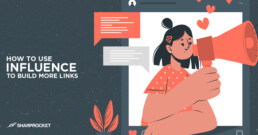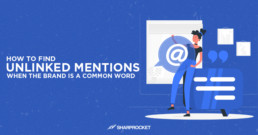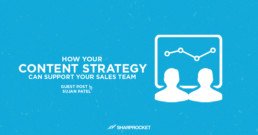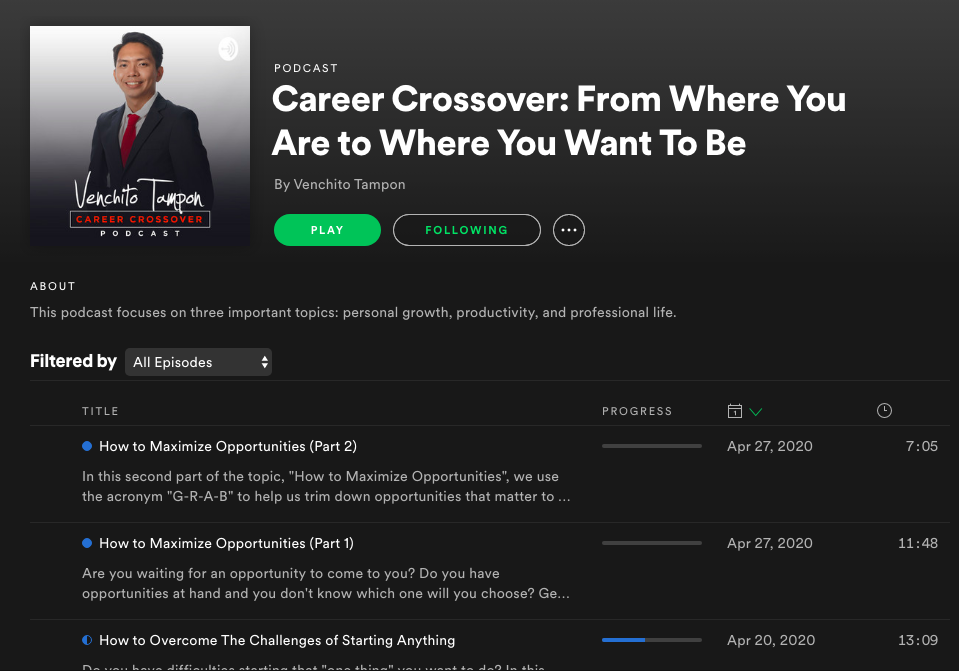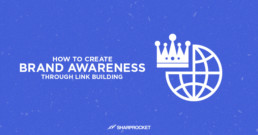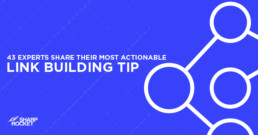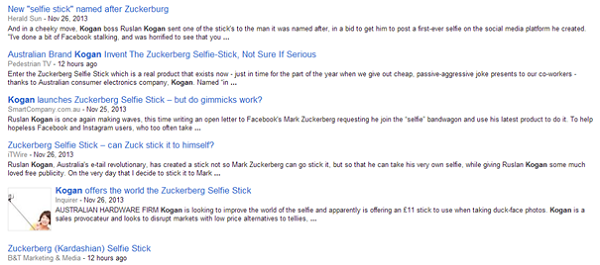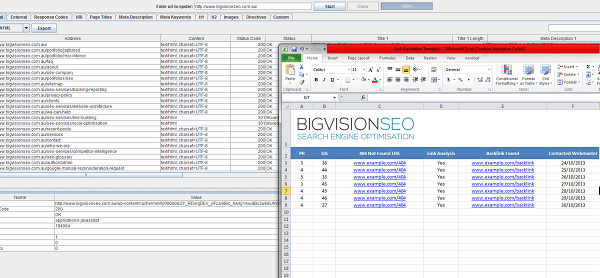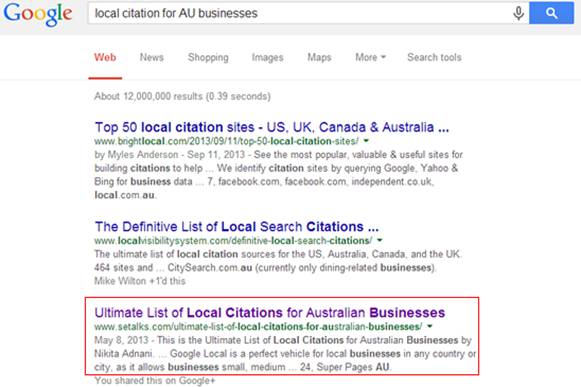How to Use Influence to Build More Links
A person with influence gets more opportunities than someone without. It's a reality most content marketers must embrace as they try to build content authority and influence through content marketing and link building.
Knowing how to use your sphere of influence has its given advantage in link acquisition. You earn hard-to-replicate links, repeated links from the same trusted domain or website, and even increase the exposure of your top or middle of the funnel content assets.
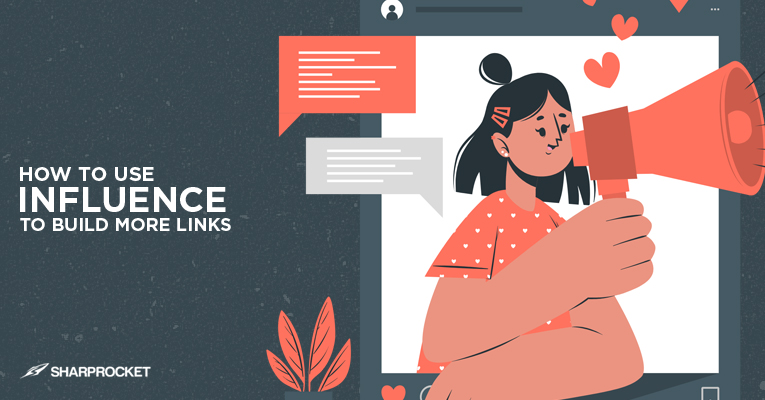
Table of Contents
In this post, we'll cover tips on how you can use a sphere of influence to build more links to your website.
How to Use Sphere of Influence to Build More Links
1. Use seed planting strategy
A subtle approach in building your influence works pretty well in establishing trust without the need to invest a huge amount of resources — whether that's financial or time-intensive resources.
The key is to look for groups of people to whom you'll be adding value on a regular basis.
You're not looking for a massive group of audience, but a small targeted group who has the potential to amplify your brand content assets.
Discover your target group of amplifiers. You can check out this latest guide by Rand Fishkin to learn how to discover small invite-only amplifier groups.
You can also create your own list by finding small to medium-sized blogs in your niche using Buzzsumo.
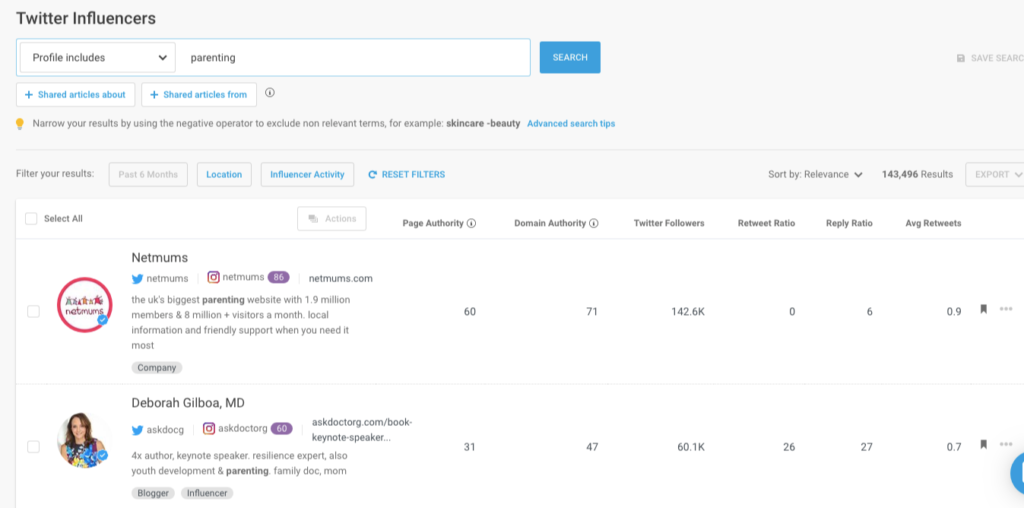
It is best to get radar of their latest posts by subscribing to their email newsletters or blog RSS feeds. This would get you notified of their new posts.
This is where the seed planting approach takes time. As soon as their new posts are published, be the first to comment.
Always add value to the conversation, perhaps ask a question. Don't just add any link to your content in your comment, unless it's relevant to the content you're commenting on.
In most cases, you use your name as anchor text to a link of your website — a standard approach on blog platforms.
Another seed planting technique is to share the latest content of your target content amplifiers. Get on their latest tweets and only share if it's relevant to your brand. Otherwise, you may come off as robotic and automated in sharing their stuff.
2. Engage in channel-specific groups
Besides creating your small list of content amplifiers that you'll engage in for further connections, you may also find specific channels where your target customers or content audiences engage in.
Here are some channel-specific groups you can consider:
- private Facebook groups
- private Slack groups
- Linkedin groups
- industry-specific websites (Growth Hackers)
- niche-relevant forums (Traffic Think Tank)
- private Skype conversations (invites only)
While not all of these you can't penetrate quickly, if you can find a few private groups where you can invest heavily in conversations, those are gems with a high return on investments.
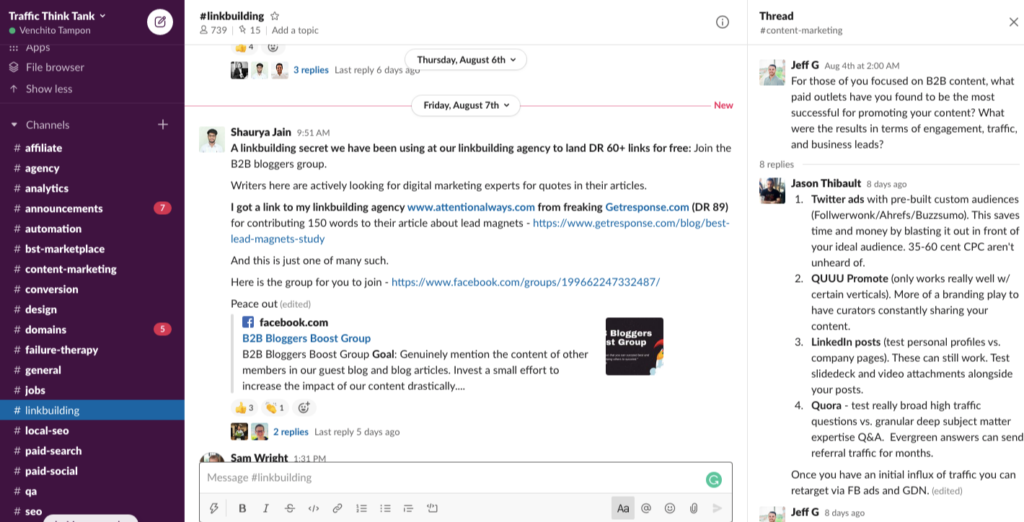
Getting into channel-specific groups has other content marketing benefits besides getting organic links. These benefits include:
- Generate new content ideas that are timely for the current business season
- Develop outreach strategies in the new normal based on engagement patterns to increase response and conversion rates
- Add more leads in your sales funnel through interested customers or clients of your services (driven by their perceived value on your engagement)
If you can look for channel-specific groups, you can engage better with your audience in a more personal, relatable approach. Thus, helping you build your brand and earn authority links.
3. Leverage LinkedIn as a subtle connector tool
LinkedIn shouldn't be a platform to spam people with straight right hook offerings (products/services).
There is a way to build relationships the right way, and at the same do link building without the need to annoy people with insensitive, non-personable messages.
Start optimizing your profile. The key is not just to introduce yourself in one message with lengthy profile credentials.
If you can provide enough details and descriptions in your profile about what you do for a living, you'll have better chances of getting more profile views. This can lead to more opportunities for connections and natural links in the process.
In addition, create a content plan for a month and have it scheduled to post for the best times every week.
You may opt to follow your existing content calendar or have a separate strategy just for LinkedIn posting.
By promoting your content assets natively on the platform, you'll have better chances of engagements, and an increase in organic reach.
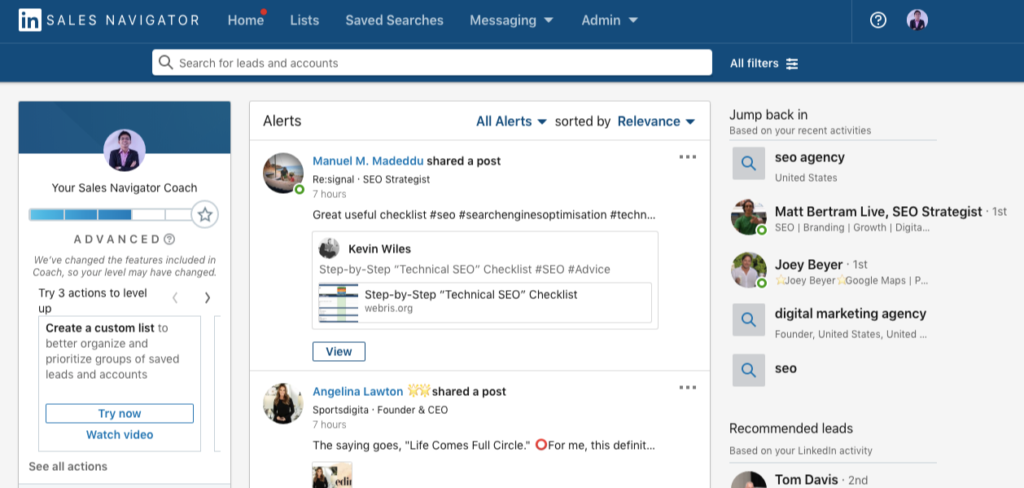
It is best to use the Linkedin premium account, particularly Sales Linkedin Navigator to maximize sending off invitations to target people. This gives you more capacity to add more like-minded influencers in your circles.
Enterprise sites can leverage Linkedin as a way to personalize their approach in connecting with their potential customers — strengthening their brands and acquiring new enterprise links.
4. Maximize attraction marketing
Influence has its advantage to attract high quality backlinks.
With the idea of marketing flywheel, you create more visibility by developing content resources that appeal to your target audience.
With organic and manual link building and content promotion, you reap your initial benefits of links, social shares, and other engagement signals. This gives you the opportunity to get more flywheel effect for your content.
Here are some ways to apply attraction marketing:
- Produce lead magnets such as checklists, top lists, and coupons — to capture email addresses, which would have an increased possibility of visibility for your future content assets.
- Develop comprehensive evergreen pages on your site that match your audience's needs (may it be a linkable audience you've chosen or a target group of influencers).
- Create timely content to attract new content consumers to your site. You can check out this guide on content marketing strategies during coronavirus.
Be A Value-Adding Influencer
Influence has its responsibility of putting people first. With this kind of mindset, you enable yourself to become a forceable brand that engages people with value-adding content assets.
How to Find Unlinked Mentions When the Brand is a Common Word
Link reclamation is a common link building technique for marketers today.
The idea is very simple: you get all those publishers or content creators who've mentioned your brand or your content but haven't linked to your site.
Then you reach out to them and ask to give you the links you deserve.
Oftentimes you gain a higher link placement rate than other link building techniques such as broken link building and guest blogging.
This is because there's already a brand connection between you and the publishers as well as an intended reason to link to you in the first place (they've used your content).
Here at SharpRocket, we've covered the entire process of this strategy in our link reclamation guide.
Like any other link building techniques, there are loopholes you have to consider by looking at methodologies that'll be effective to solve those particular problems.
In this post, we'll cover one common challenge link builders face when executing the link reclamation technique.
That challenge is finding unlinked mentions when the brand is a common word.
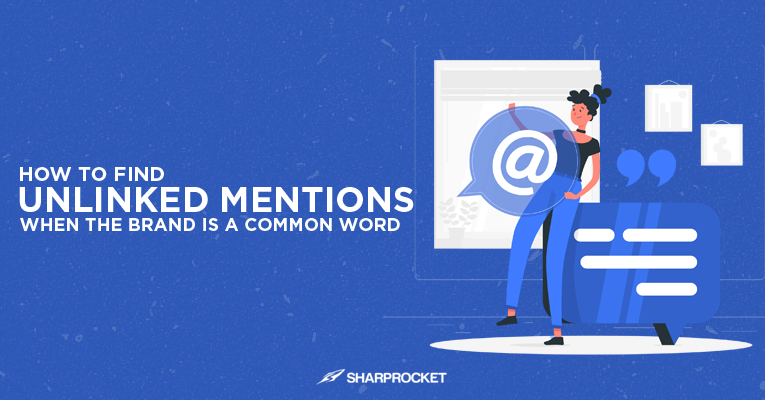

It's easy to spot pages that mentioned your brand if you have a unique brand name — i.e. Nike, Spotify, or Shopify.
There may be misspellings or typos as to how publishers may have mentioned your brand name on their posts — such in the case with Spotify or Shopify.
What is difficult to surface with are brand names with common words like Monday, or Apple. Monday is a project management software but is also referring to day itself. Apple as a technology company, while referring to a fruit.
As you go search for pages that mentioned your brand, you're likely to see different results. What do you do to sift through these results to only find relevant outreach prospects?
Table of Contents
On Link Prospecting Phrases
Regardless of the tools, you'll be using for link reclamation prospecting, you need to have a list of words that should be associated with your brand.
In particular, these are your product types, product or service descriptions, or that one or two word detail about your brand.
Let's take Monday as our example. Monday is a project management tool. So, obvious words likely to be associated with are: 'Monday project management' or 'Monday task management'.
If you're working as an agency and this is your first client, you get to have a better understanding of your initial meetings with them. Having a good grasp of what they are and their products or services offer to the market would give you a list of words that define their brand as a whole.
You may opt into some research on Google by typing their brand.
For instance, a Google search result for Monday gives you the site's meta title and meta description. These are keywords the brand is trying to rank for in search.
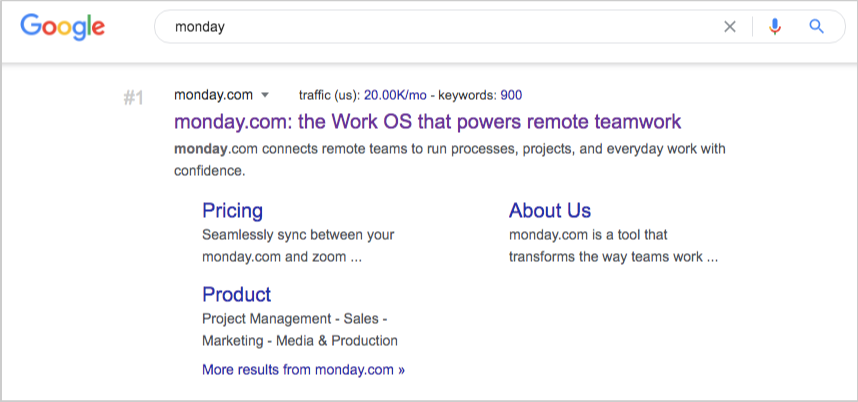

Add these words as your associated phrases to your link reclamation prospecting process:
- Monday remote
- Monday remote team
- Monday teamwork
- Monday remote teamwork
- Monday processes
- Monday enterprise
- Monday project
Another way to discover words you can add to your link reclamation prospecting list is by going through all of the existing mentions of your brand.
You can use Ahrefs Backlink Explorer to find pages already linked to your site. I prefer checking in pages where publishers usually linked to. These include your site's homepage and landing pages (e.g. product pages).
Sift through the pages and identify anchor texts publishers used to link to your webpages. There will be variations of anchor texts — long-tail description words and co-cited way of referring to your brand.
Add these newly discovered phrases (used as anchor texts) to your current link reclamation prospecting list.
Tools to Find Unlinked Mentions When the Brand is a Common Word
Link building requires some tools to surface brand mentions. Here are some tools you can use to find unlinked brand mentions.
1. Ahrefs Content Explorer
One of the tools that can help you with the link reclamation prospecting process is Ahrefs' CE.
There are a lot of advanced search operators in CE. If you're looking to return all pages that mention "Monday" AND either remote, team, process, project, management. You simply use "OR" to associated phrases.
So, the final advanced search query would be this: "Monday" AND ("project management" OR "remote team").


If your brand is a very common word, make sure you choose phrases rather than single words to return pages closest to what you are looking for.
Another strong tip is to exclude terms that refer to other topics not related to what your brand is about. For Apple, that might be "recipe", "pie", "cake", or "fruit" to exclude pages about the fruit term.
Be mindful that this may be tricky for some brands. In our example, "Monday" project management tool, if you exclude terms such as "day", "week", "month" or any calendar terms, you might end up excluding pages that mentioned both "day" and "project management" (which is about your brand) in the search results.
Hence, use exclusions if it makes sense to your brand.
Kindly click highlight unlinked domains and add the domain of your site. The websites of publishers that have never linked to you before will be highlighted, which means that the brand mentions those pages are unlinked.
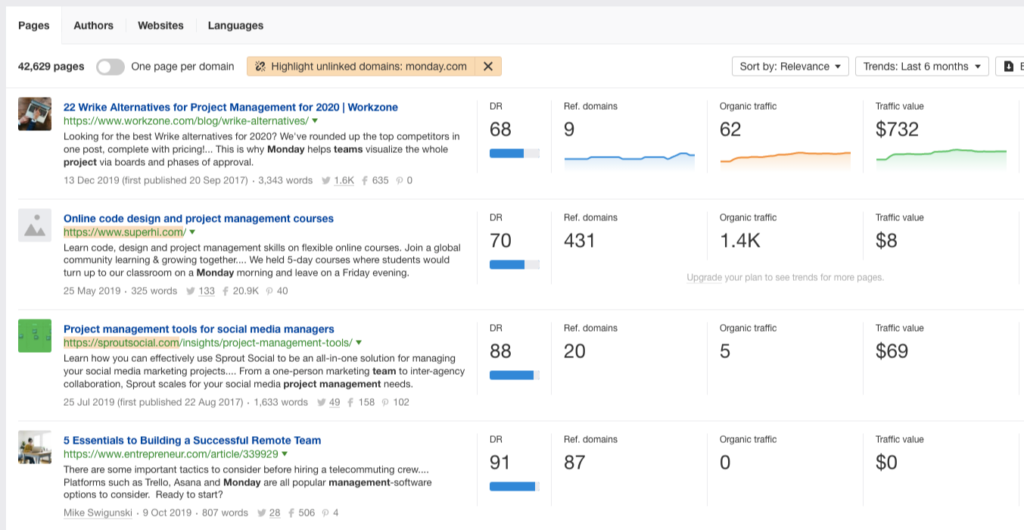
2. Web mention tools
In link reclamation, you can't get away from using web mention tools. These are web products specifically designed to find pages of your unlinked mentions.
Examples of these are Ahrefs' Alerts feature, BrandMentions, and Google Alerts.
The same strategy with your search query inputs can be applied to web mention tools.
You can use any of the following search queries as your alert inputs.
Again, in our example today, you can have these queries:
- Monday remote work
- Monday remote team
- Monday teamwork
- Monday remote teamwork
- Monday processes
- Monday enterprise
- Monday project management tool
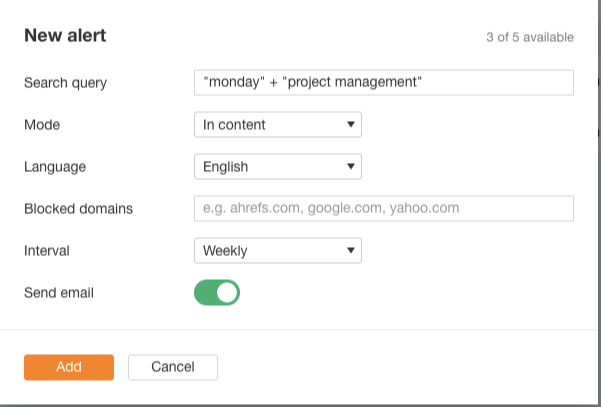

Exclusion and inclusion filters are also available in mention tools (AND, OR, —). Use them to your advantage to filter out irrelevant pages of your unlinked mentions.
Link Reclamation Made Simple
The most difficult challenge in link reclamation is sifted through results from your methods of link prospecting — manual and/or with the use of web mention tools.
If you're an agency, you get to master this strategy over time, as you can unpack ways to figure out how to discover unlinked mentions when your clients' brands are not common words.
Do you have any other tips to prospect for unlinked brand mentions? Let me know in the comment section below.
Do Enterprise Sites Need to Build Links?
Enterprise link building is a different landscape. It requires a need for planning and knowing what expected results you want from a link acquisition campaign.
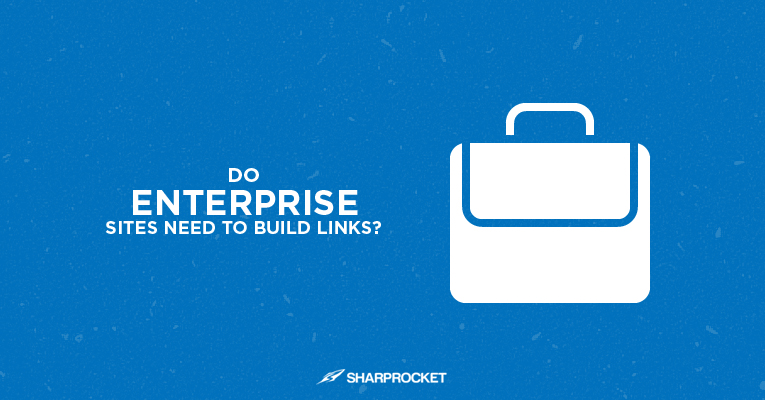

In today's post, we'll cover the need to build links for enterprise sites and understand what types of backlinks that will bring high brand value to them.
Table of Contents
Do Enterprise Sites Need to Build Links?
The quick answer is yes.
Essentially, big enterprise sites are getting organic links, even without the manual link building campaigns.
Given their high-level top of the funnel and mid of the funnel content pieces, enterprise brands earn various types of links that bring more backlink growth than most small to medium business sites get.
However, most enterprise brands are not just waiting for links to come, but rather are more active in pursuing links. This is what we want to dig deeper a little bit — as to what types of links enterprises should be building for their sites.
Considerations When Building Links for Enterprise Sites
Since we are working with enterprise brands, we know what they're usually after in a link building campaign and what they do get out of it.
For many SEO and link building agencies, they know that once these enterprises' director of marketing or director of SEO reached out to them, these people know what to actually look for.
Though some may take some serious study and may need to be educated on why SEO matters to them, most enterprise clients who reached out have a good understanding of their needs.
Targeted Types of Pages
To be more effective in an enterprise link building campaign, one has to know the types of pages he/she should start prioritizing from the very start.
Generally, the focus of driving links are into core product pages — these are product pages that convert so well from sales and leads standpoint, but maybe struggling to get a ton of links.
To find viability for links, enterprise SEO teams will have supporting content guides internally linking to these product pages. These supporting pages will be used now as the value proposition to garner blog links or editorial links straight to them.
Another strategy is to add more informational elements (we call it as citable elements) to landing pages, such as product pages. By doing so, you get to serve a specific group of linkable audience and thus increase the likelihood of getting high authority links.
There is no successful link building campaign that will spend lots of money on random links. Enterprise sites have targeted pages they consider as part of their link building strategy.
Quality VS Quantity
Enterprise sites are aiming for both quantity and quality of links. They want to drive more, but highly relevant and authoritative links.
These authoritative links may have different benchmark metrics depending on which agency they're partnering with.
All backlink prospects should be relevant to the brand's content theme. It may be coming from industries, but sites that have engaged audiences enterprises cater to.
Besides relevance, metrics that I've found to get more buy-in from enterprise sites is the website's organic traffic, traffic cost, and brand value.
SEMRush helps you show websites' organic traffic and traffic cost. This gives you an idea if the website gets constant visibility from ranking pages on search — providing you with more referral visitors to your site.
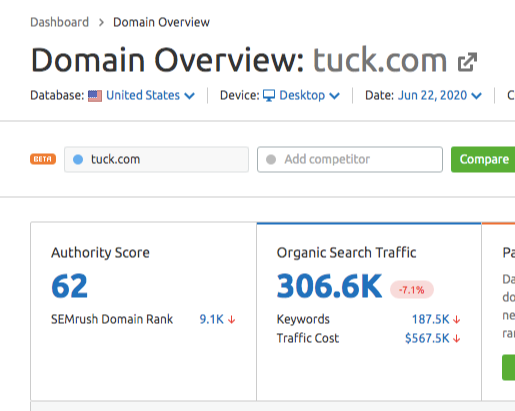

Brand value is also a key factor to consider in prospecting for relevant authoritative websites. This refers to how you see the potential linking site to give you better returns in branding impression as you go and get links from it.
Link Value Ratio
One of the big problems of many enterprise brands is not considering the link value ratio when executing a link acquisition campaign.
If you spend big budgets to build links to target pages that don't have any ranking and money potentials, you'll miss out on great opportunities that should've been invested in other content marketing initiatives.
Here is a great reference by Ross Hudgens that shows you how to compute for link value ratio.
Tactical Link Building for Enterprise Sites
A. Internal Linking
Oftentimes enterprise-level sites overlook their ability to leverage their internal linking capabilities. Their hundreds or thousands of pages can make wonders in terms of getting "quick wins" that they could have missed earlier if they proceeded right away to traditional link building.
Build internal links to funnel link equity to your most important pages. There are different ways to attack this one, and I recommend available resources below:
B. Link Reclamation
One of the best things to leverage in an enterprise site is its ability to capture the unlinked brand mentions from many sources.
A product worth mentioning on a blog post, a press release about your latest product feature, an interview about your executive about the changes happening in your company (or in your industry) are just some of the things you can monitor on a regular basis.
You can reach out to relevant publishers, content creators, or bloggers who mentioned any of your brand content (has your unlinked brand mentions) on their pages.
Get them to link to the most relevant page on your site.
If you're looking for a detailed process on this link building strategy, you can check out my guide on link reclamation.
C. Strategic Content Partnerships
As a link building company working with enterprise clients, what we've found to be a unique proposition for big brands is their pool of partners.
Those partners that they've built over the years can help set up collaborations much easier than usual.
Strengthen the brand more by associating it with well-liked entities. You can collaborate with other well-known content creators in producing a linkbait piece of content targeted to specific audiences.
Through content collaboration, you capture each of the content partner's followers and readers.
Another way to build high-value blog links is to create connections with authors who write for multiple websites about your industry.
These are authors who develop their personal brands to disseminate their messages in content by submitting guest posts to top-niche blogs.
So instead of the traditional guest blogging where you blast out distributed content to different blogs, you put your brand in a position where these guest authors come to you for links (link earning).
D. Reverse Outreach Campaigns
Reverse outreach is a strategy enterprise brands can take advantage of.
Instead of solely doing direct outreach to relevant publishers and content creators for external content distribution, they can leverage the power of linkbaiting — creating high-value pages to earn authority backlinks.
Since brands have strong domain power, they can rank pages for keywords in a short period of time.
One link building technique (earlier been mentioned) is the idea of inviting influential content creators to contribute and/or collaborate content for your blog.
The beauty of it is that you gain new expertly-crafted content pieces every now and then. You also acquire new links from these guest posts as they reference it (or externally link to it) from their other externally distributed content (guest posts).
Create more interesting content assets on your blog to attract links from relevant publishers as well as receive more targeted pitches from guest authors. Well then, you have your set of rules to select only practitioners who can write for your blog.
Having a reverse outreach strategy in place will keep you earning links consistently to your site.
Maximize Your Strengths As An Enterprise Site
There are many competitive advantages of running a link building campaign for an enterprise brand. With proper research and planning on highly performing linkable assets to inform future content creation decisions can help get low-hanging fruits of links.
Are you currently building links to enterprise site/s? Share any other link building tips in the comments below.
How Your Content Strategy Can Support Your Sales Team
Whether you call it content marketing, inbound marketing, or any other related term, the use of content to advance a business’s goals almost always falls under the umbrella of marketing. But don’t pigeon-hole content. By taking a broader view of content’s potential, you can identify plenty of ways it can be used to support your sales team as well.
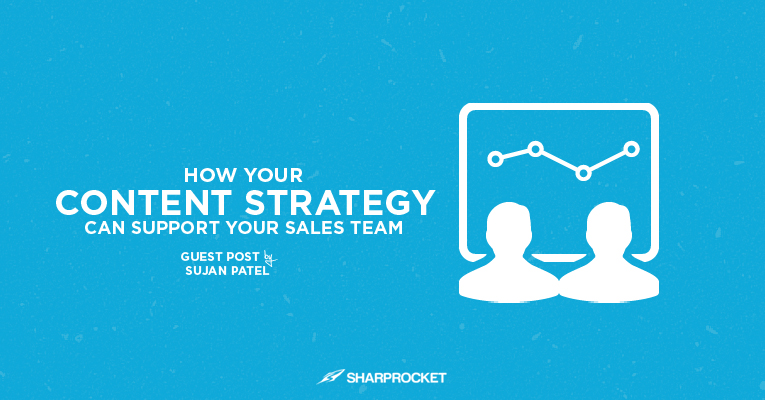

Marketing and sales don’t always play nice together. Marketing can execute brilliant, compelling content, but if it isn’t used by sales teams, it may not get the attention it needs to pull its weight from an ROI perspective.
Conversely, sales teams that plow forward without making use of the content assets available to them risk hamstringing their effectiveness, as more and more buyers prefer to engage with marketing content before ever connecting with a salesperson.
Table of Contents
For your content strategy to support your sales team, you need to think about content through a broader lens. Here’s how to do it:
Understanding the Buyer Journey
If you’re going to use content to support elements of your sales cycle, you need to first understand the foundational concept of the buyer’s journey. Typically, this idea is presented in the shape of a funnel, split into different stages. Though exact funnel models vary, most include the following stages at a minimum:
- Awareness: A prospect becomes aware of a need they intend to fulfill through a purchase.
- Consideration: The prospect considers different potential solutions to their need; for instance, by evaluating your company against its competitors.
- Purchase: The prospect decides on a solution.
Some models include a post-purchase stage, while others break out the three above into more granular needs. Regardless of the specific approach, a few things hold true about funnel-based buyer journey models:
- The funnel shape is used to signify the natural attrition that occurs throughout the buyer journey. Not every prospect who becomes aware of your solution will become a customer.
- The amount of time prospects spend in the funnel depends on factors such as the significance of their need and the cost of your solution.
- Although prospects may not move through the funnel in a linear fashion, they must have their needs met at each stage before they become a customer.
Expanding on that last point, a prospect isn’t going to buy from you if they aren’t aware that they have a need to fulfill. Similarly, it’s unlikely that they’re going to buy from you without considering possible alternatives.
The good news is that, because we understand that prospects have questions that must be answered and need that must be fulfilled at each stage, we can transform these insights into content assets that can be used to support the sales team.
Here are a few strategies for doing so:
Creating Content Around Specific Product Features
In the Awareness and Consideration stages of the buyer’s journey, it’s common for prospects to have questions about specific product features.
Imagine that your company has identified a need for a new project management solution. You aren’t going to go out and sign up for the first Google result you come across. Instead, you’ll probably approach your decision in a more thoughtful way – such as by creating a list of must-have vs. nice-to-have features to guide your search.
Now, let’s assume that one of your team’s must-have features is integration with your existing CRM. Would you be more impressed by a salesperson who couldn’t give you a clear answer on whether or not their project management system integrates with your specific CRM? Or by one that can immediately send over one-pager listing popular integration, along with links to complete instructions for setting each one up?
As an example, take 17hats, a business management system for solopreneurs. The company’s help section features an extensive list of integration tutorials, including the instructions below for its Quickbooks Online integration:
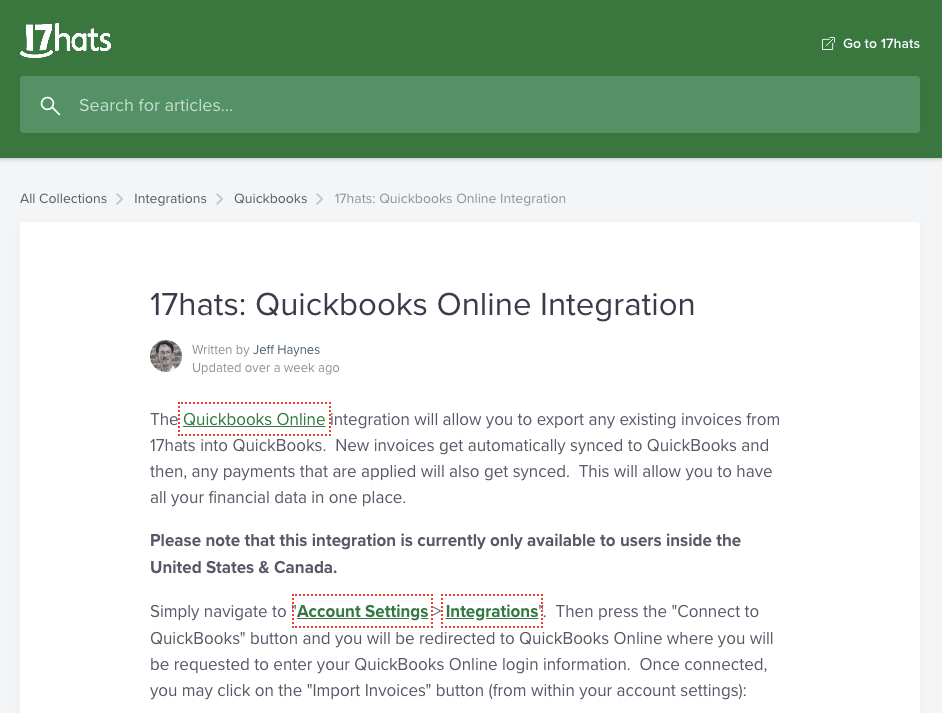

There are several things you’ll want to keep in mind when creating content around specific features:
- Not all buyers will be interested in the same features. Work with your company’s sales team to identify which features the prospects they talk to are most interested in so that you can prioritize your content building efforts around them.
- Prospects prefer to access information in different ways. Will they be printing assets for future reference? Would they like to read instructions or watch them in videos? If you or your sales team aren’t clear, you may need to test a few formats to get a better feel for how to allocate your content creation efforts.
- Creating feature-specific content won’t move the needle for your sales team if you don’t also give them an easy way to access it. When they’re chasing a hot lead, few salespeople are going to stop to search for that content piece you sent across months ago. Build an easily-accessible content library, and conduct regular training on new additions so that they can put your content to work.
Creating Content Around Common Sales Objections
Your next source of sales-specific content inspiration should be the sales objections your company commonly faces.
Sales objections are the problems that keep prospects from moving forward in your sales process; they’re the reason each subsequent funnel stage is smaller than the one before it. The ability to address them successfully is a major determinant in sales success, but content can go a long way towards supporting the process.
According to Jace Ermidis in an article on the SalesForce Search blog, five of the most common sales objections encountered by teams include:
- Price, specifically because buyers “think your prices are too expensive, they can get a better price from a competitor, or they don’t have the budget.”
- Fear of changing the status quo, given the extra work a new purchase represents.
- Trust, in terms of whether or not buyers believe you can deliver what you’re promising.
- The timing of the proposal, relative to internal happenings at the company or other external events.
- The absence of a true need – whether it’s actually true that prospects don’t need what you’re selling, or whether they’re just saying that to get out of the sales process.
Opportunities exist to address each of these objections with content. For example, take a look at this blog post by Savoya, a black car service supporting executive travelers:
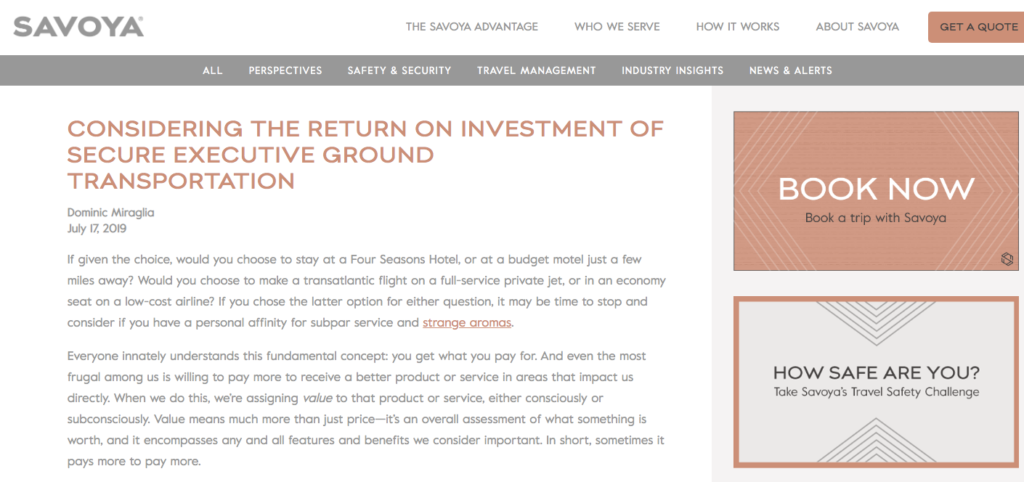

Understandably, executive ground transportation services are more expensive than taxis or services like Uber and Lyft. And given that the company likely faces the pricing objective on a regular basis, it’s used content pieces like this to contextualize the full value provided by the service in terms of the total ROI achieved by its customers.
You can do the same thing with sales reports. Check-in regularly with your sales team to learn what objections they’re facing most frequently. Look for opportunities to communicate your company’s responses through content, and you could take a huge amount of pressure off your salespeople by resolving the issues before conversations even begin.
Creating Content Around Customer Use Cases
Finally, use content to prove to customers that you can solve their problems by showing how you’ve done it in the past for similar clients. You may already be using gated case studies for this purpose, but don’t limit yourself to this single content type.
For instance, you could also leverage the power of use case content by:
- Inviting your top customers to contribute guest posts to your company’s blog
- Featuring them in webinars that walk through the issues they were facing and how your solution solved them
- Asking them to share a quick screen capture recording sharing what they like most about your product
- David Campbell, marketing lead at Right Inbox recommends isolating key quotes from your case studies and designing them into eye-catching social media graphics.
- Integrating use case elements into product or service description pages
- Developing a SlideShare presentation based on a customer’s story
As an example of that last strategy, check out Uniface’s case study for its customer, Synapse Innovation, which has been viewed on SlideShare more than 274,000 times:
Getting Sales Onboard with Content Marketing
As noted above, all of the content creativity in the world won’t have an impact on company performance if you can’t get sales fully onboard.
Test the strategies described above, but also test how you can best integrate your new initiative with your company’s salespeople. Do they respond best to email notifications of new content? Should you connect with them via Slack? Which content pieces seem to have the biggest impact on sales conversations, and why?
Expect that your process will evolve as you iterate based on feedback from sales and the numbers you’re seeing in your marketing analytics programs. With time, you’ll be able to adjust your content strategy and allocate your execution resources in order to properly support your sales team.
Do you take your sales team into consideration when planning your content strategy? Share any other tips or tricks you’ve learned in the comments below:
5 Ways to Build Links to SaaS Template Pages
If you are working on a SaaS (Software as a Service) website, then there are certain pages you want to target for links.
Either the page hits your bottom of the funnel (generate direct sales or leads), or it's part of your top of the funnel pages — to gain the interests and attention of your target audience without directly selling to them right away.
One type of page of SaaS sites that SEOs and link builders are having difficulty getting attention in terms of links are "template pages".


Table of Contents
Insights On SaaS Template Pages
With template pages, it can be as helpful for your target audience — as it teaches people how this little tool solves a particular need (e.g. invoice templates for small business owners).
Your SaaS template page can also directly tied to your products, giving people a step by step guide on how to use the template along with the software your brand offers.
The second type of template is the most challenging. You often SaaS template pages attached to products - which makes it salesy.
If you've been building links for a while, you know sales pages don't get many links, as linkers find it uninformative for their target audiences.
In this post, we'll cover 5 ways to get backlinks to template pages of SaaS websites.
1. Learn from template-specific sites
It's no wonder to find it difficult building links to SaaS template pages.
But one of the key methods to discover if there are link opportunities for that specific type of page is to go look for template niche websites.
These are websites with template only content.
Take a look at this example:
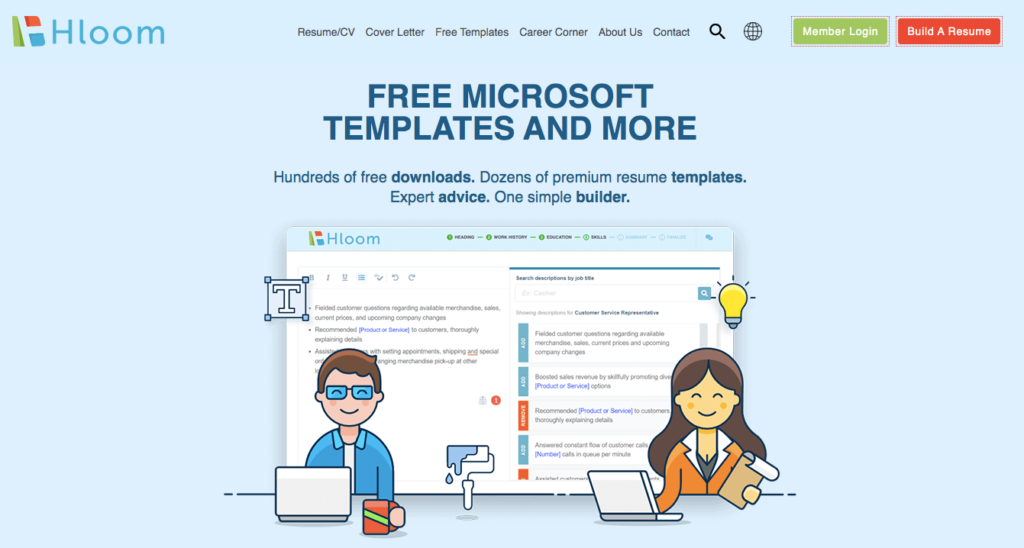

Hloom provides hundreds of Microsoft templates on the subject of career. They've been pushing high-value linkable templates that no one else in the market can publish.
What makes Hloom's templates linkable?
Their template pages are tied into other linkable content pieces.
The 100+ template content asset may not be highly linkable at the start, but accompanying it with other related linkable assets makes it easy for content consumers to see the template piece.
You can apply the same strategy to your SaaS template pages. Can you internally link to the page from other related more linkable content assets?
Sidenote: 5 Linkable Assets Examples (How to Create and How to Build Links to Them)
In our Hloom's example, resume templates page is tied to other related pages like, "How to Write a Resume", or "Resume Formats".
By adding internal links to your template page from other more visible pages, you're likely to get more eyeballs and potentially attract links to your main piece — your template SaaS page.
Another way to make your template asset increase its linkability is to add FAQ (Frequently Asked Questions) and even a section that shows how to use templates. In Hloom's case, there's a section on "How to Use Our Resume Templates".
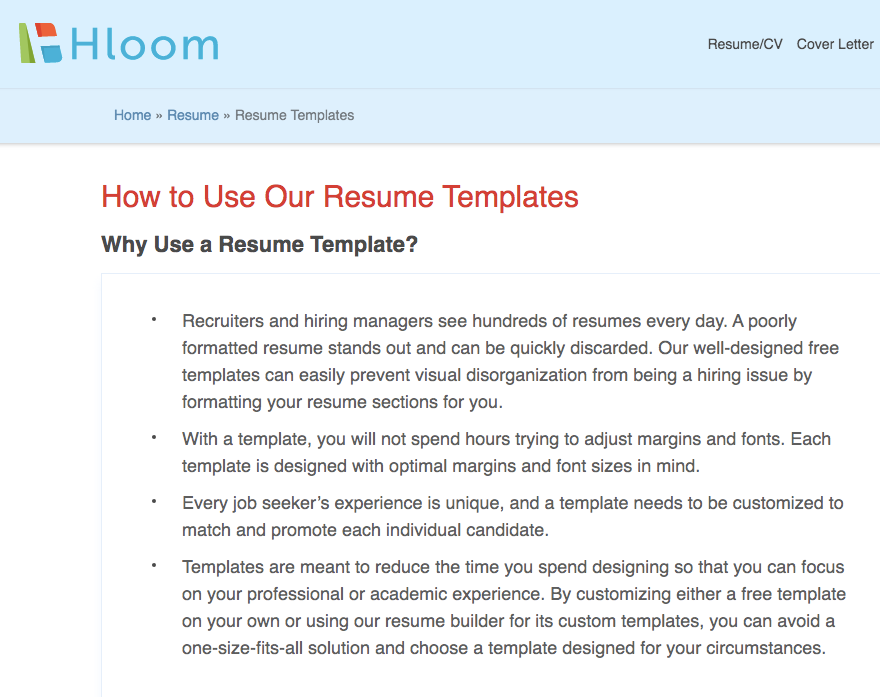
2. Add citable elements to your SaaS template page
The hardest part of link building for SaaS websites is justifying the "citability" of your page. If it's too salesy, you're less likely to get links.
But that's not the case if you add citable elements.
What are these citable elements?
These citable elements are more informational and educational for a targeted audience. It's different from pure sales content, as it is more referential in its nature.
Here are some citable elements you can add to your SaaS template page (as mentioned by Garrett French):
- Data or “findings.”
- Direct quotation of a source.
- Defining jargon and industry terminology for the layperson (aka definitions).
- Pricing Guides or Generalized Pricing Information.
- Images, Videos, Widgets, Downloadables.
- Detailed, Multi-Faceted Metrics-Based Reviews.
- Tips/Advice Directly Related to Products/Services on the Page.
- The Origin Story.
- Supplemental Outbound Resource Links.
Apply it to the context of your industry and to what your target audience is looking at in terms of links.
You may find that by simply adding a "data" or "findings" will work wonders in gaining links to that page.
Double down on those efforts if it brings you maximum impact on links.
You can check out my guide on creating resource pages if you want to know more about linkable audiences.
3. Leverage resource page opportunities
When there's a justifiable reason for citing your SaaS template page, there is likely a certain type of link opportunity.
For template pages, the most common type of linkers is resource curators.
In our Hloom example earlier, you'll see bunches of resource curators - seniors, students, parents of teenagers, and people with disabilities looking for job opportunities.
Fortunately, the template piece serves many resource curators audiences. That may not be the case for your SaaS website, what you can do then is to tie it to or add a citable section to your template page that may well serve any of the linkable markets below:
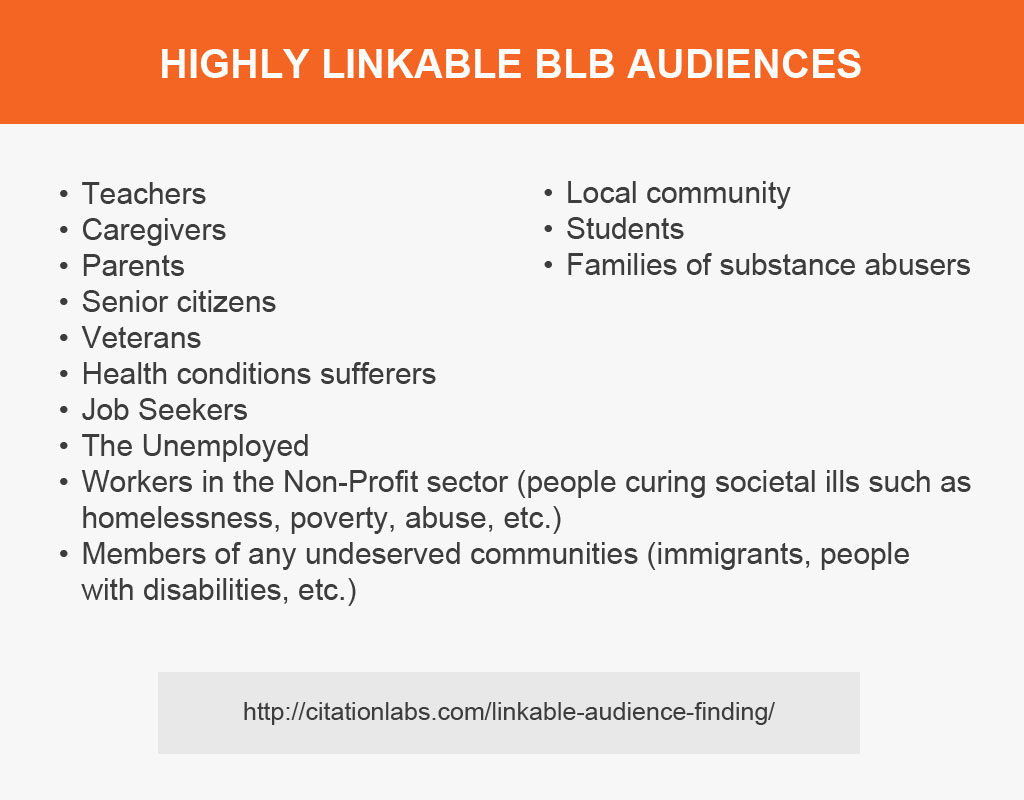
4. Build landing page links with brand mention outreach
Depending on how huge your SaaS website is, you'll manage to find a lot of unlinked mentions of your brand, most of which will come from pages citing or referencing your tech products.
Most of those brand mentions are primarily for your homepage.
That's okay. But you want to get more specific links — more relevant links, if you may.
You can ask publishers who've mentioned to direct to your SaaS template page — you may see at times that these publishers are receptive to your link requests.
Instead of them giving links to your SaaS homepage, they could link to a more relevant page — SaaS template or your product page.
There are many tools to help you out with the brand mention tracking process — one, in particular, is BrandMentions by Razvan Gavrilas.
Here are more resources on brand mention tracking:
5. Tap off-site brand content like blogs
Take the "restaurant website template" as an example.
It's not a solid linkable piece if you ask me. But there are ways you can go address the needs of business owners, which makes the content more compelling for linkers.
You can search for blogs and look at any topics that might seem more relevant for entrepreneurs. Topics like smb management, digital marketing, or customer relationship management.
You can apply the same method to your brand context.
Check any bloggers and other publishers in your industry that post about "things to consider" or "how-to" articles where the topic of your SaaS template page may contextually fit, at its best.
By doing some research on maximizing "offsite brand content strategy", you'll find ways to penetrate bloggers in your space.
Make Your SaaS Template Pages Link-Worthy
If you're a SaaS founder, marketer, or SEO, you know this part is difficult to execute. But there are methodologies and actionable tips you may find useful in this post. Apply it to your own context and let us know in the comment section below your experiences, so far.
How to Use Webinars For Link Building and Lead Generation
Webinars are all over the place. From left to right, we see entities, businesses, and individuals using webinars to promote their own messages to people — whether for the purpose of educating their audience or selling them products or services.
What makes webinars so useful is its built-in value where knowledgeable experts share their insights on a given topic. The value of content increases even more as the expertise to skills becomes more relevant and more useful to the audience.
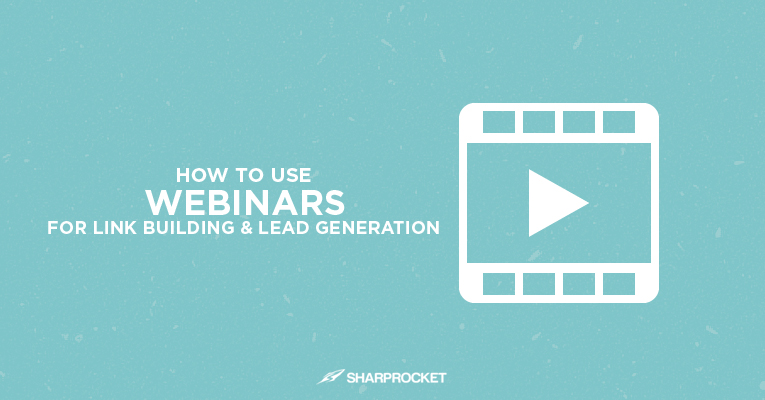

There are different formats of webinars, most of which come with a full seminar-like discussion on a subject matter. Others prefer to have an interview or Q&A type discussion with esteemed guests.
This now gives us a full reason to maximize webinars for the purpose we're engaged in.
In this post, we'll cover how you can use webinars for link building and lead generation.
Table of Contents
How to Use Webinars For Link Building
Content is king - no doubt. If you don't have content to offer to potential linkers, you're less likely to get links. Even if you have established thought leadership and authority in your space, you still need to produce content pieces to attract high-quality backlinks.
Webinars help you pursue link building. You only need to be strategic in how you develop this content piece and distribute it massively to your target audience.
Guest on topical webinar series
First in the list of link building techniques is reaching out to content developers with webinar series. These webinar series feature guests in the industry who can be part of the discussion — either as a webinar lecturer or guest interviewee.
Take advantage of this opportunity given that you can hit two birds with one stone — get links from webinar transcripts (once the content is published on the creator's blog) and increase brand awareness for your site.
Take a look at this webinar series by Search Engine Journal.
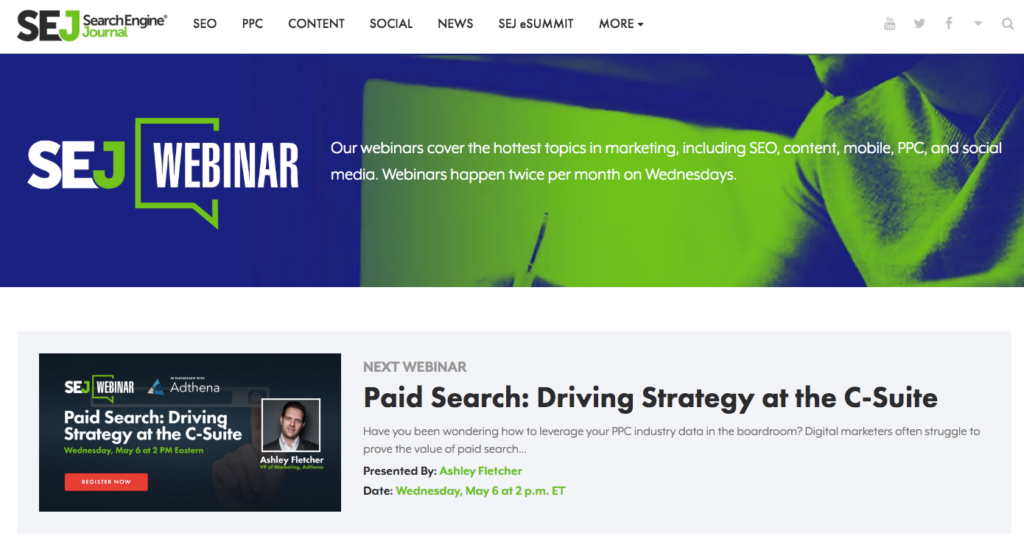

Start by searching for links of webinar series creators in your space.
You can use Google search using search phrases, like "webinar series" "INDUSTRY" or "webinars" "INDUSTRY".
Create a spreadsheet to fill in details of your target webinar creators. These include website name, the title of webinar series, host, and contact information. This helps you easily track the progress of your outreach once you begin with sending email pitches.
When doing outreach to webinar content creators, use your expertise, and describe how it can be of help to their audience. This is your value proposition — at its best. Maintain the conversation with your intent of providing more value to their followers than just appearing to be going only after for links.
Distribute webinars as guest posts
Another way to maximize webinars for link building is through the distribution of webinars as guest posts.
Essentially, you don't simply send links of your webinar videos to your target prospects. You check first with target guest blogs what they want as topics for their audience.
This is where you should play creatively. You can use the topic of the webinar as one of your suggested guest blogging ideas.
In addition, you may also chop a webinar into different topics (if the content is full-packed with information) and suggest these topics to your prospective publication.
You can check out this detailed guide on scaling guest posting ideas.
You can transcribe your webinars and turn them into actual guest posts (with edits on the side).
Another means is to only get insights and points of your webinars, use them as your outline, and write a guest post from scratch.
Both ways can help you craft a high-caliber guest post for your target blog.
Turn webinar slides into infographics
You want to maximize every piece of production for a webinar. That includes the slide presentation used for the discussion.


You can turn webinar slides into some kind of infographics, particularly if the points or information are easily digestible in an infographic format.
By outsourcing graphic works to a freelancer, you can automate this process of turning webinar slides into infographics. This makes more ROI positive if you are doing webinars regularly whether for internal or external production channels, as you get more infographics produced from many webinar slides.
Besides for link building purposes, webinars are also utilized to generate leads for a business.
Let's discuss how you can use webinars for lead generation.
How to Use Webinars For Lead Generation
As I've mentioned earlier, webinars have built-in value if it's presented by thought leaders in the industry. That makes it easy for content teams to get visitors to flow through the marketing funnel — potentially hitting the bottom line of new customers.
One high utility of webinars is making it as a bait for visitors to collect their email addresses in exchange for the video content.
Landing Pages
Create a dedicated landing page that emphasizes what your content consumers can get out of your webinars. Ensure you'll have forms to capture their email addresses. Example of which is this webinar landing page by Wordstream.
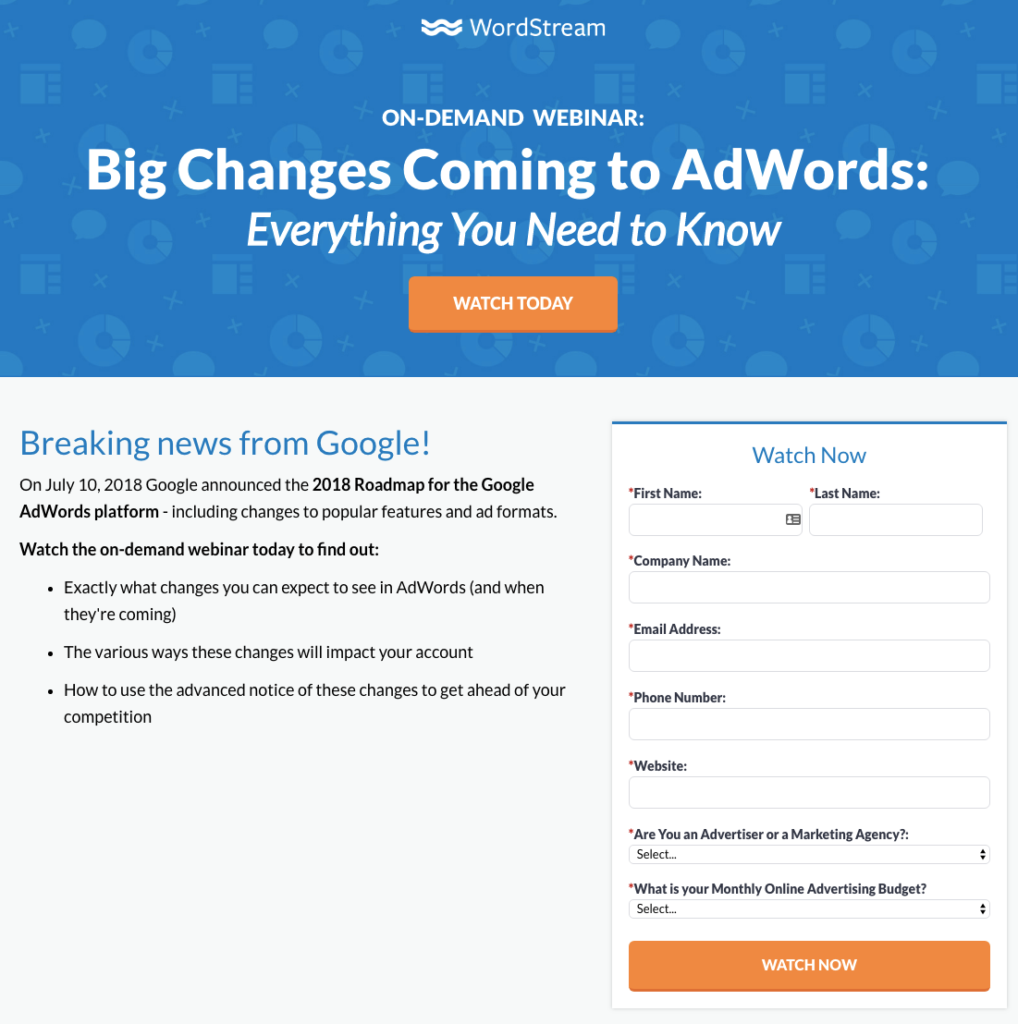
Short Videos
In the age of distractions, people tend to lose their attention quickly on long video messages. That being said, putting a webinar for them might require that your content is of high value in order to retain their attention.
The best way to capture more interests and make your brand gain more visibility is to chop webinars into short videos. These are videos that can stand on their own and can be disseminated quickly depending on how good your short video is.
What you want to do is to edit short videos in such a way that it highlights the value of information without losing much interest from its prospect watchers.
So, how do these short videos play in generating leads?
As you get more eyeballs to your micro content, you generate awareness of your brand, hitting two sections of the funnel — Attention, and Interest.
Podcasts
Podcast consumption has increased dramatically for years now. Taking advantage of this opportunity can help your business improve its lead generation activity by numbers.
Format webinars into audio content. Start a podcast featuring these new content pieces from your webinars. Repackage it such in a way that it keeps listeners engaged.
Key Takeaways
Don't just ride on the current trends in marketing where everyone is into webinars. Remember to have a good strategy and set of action plans to be able to maximize what you have produced in order to build more relevant links — and eventually, generate leads for your business.
Give consideration to how you distribute webinars to your target audience as this will help increase visibility and likelihood of your campaign success both for short term and long term goals.
How to Work Remotely With Link Building Teams
Given the Covid-19 Coronavirus crisis, many companies face new challenges in transitioning to a new work environment. While remote work setup is being practiced by many brands in outsourcing industries, a lot of adjustments still have to be made.
Working remotely is a new skill.
More particularly, if you are working with a team, it takes a little while before your team can transition smoothly to an efficient and effective system of remote work.
There are a couple of guides available to get you started with remote work. Here are some useful resources that you would find to be useful:
- A Complete Guide to Turn You Into a Pro by Paymo
- Answers to Remote-Working Challenges
- Remote Work Guides and Tips by Aleyda Solis
As a link building agency, we've transitioned to full remote work setup weeks ago (as of this writing). This brings us lessons from experiences ourselves and from observations on other SEO agencies and link building teams.
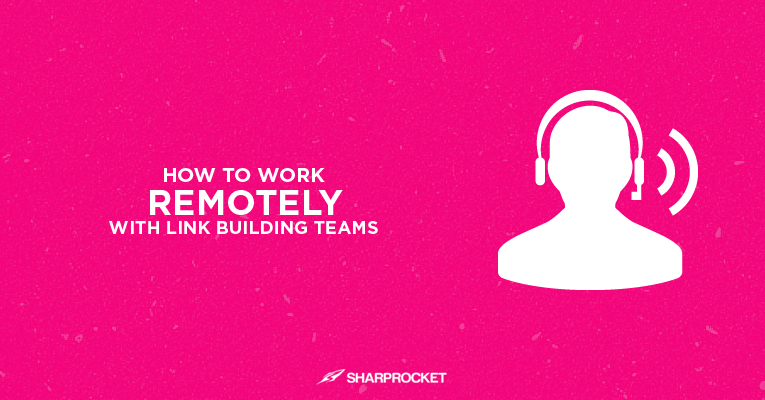

Table of Contents
On Working Remotely
You can't have the full same format of work in office applied to work from home setup. These two are different.


For instance, communication should be more prompter than usual, as the only way to get things done is through faster feedback on tasks. Another is of usage of some software for work. Cloud-based types of software must be more often than not, be used by teams to organize projects and to designate tasks properly to members.
How to Work Remotely With Link Building Teams
This is not a comprehensive guide for working with remote teams. But rather, focus specifically on link building activities, and tips on working with link building teams to achieve link goals for clients.
1. Create performance reporting documents
In many brands, they call it as key performance metrics KPI reporting sheet or document. For content teams, that may be the number of content assets produced during a set period of time. For us, link building teams, the range number of editorial links delivered to our clients for their target pages.
It's essential to have one for your link building team. First, you get them accountable to monitor their own performance at work. Second, you measure their productivity based on the highest impact and highest flexibility of tasks they do on a daily work basis.
Have a performance reporting document set up for your team. You can get a manager to monitor and have documents ready for you or you can do it yourself.
2. Plan out your teams' daily or weekly schedules
Once you know your key performance indicators (for some, this has been identified before even transitioning to remote work), start planning your team's work schedules.
Not everyone will have the same work schedules, depending on the volume of work you have as an agency. Some teams may be skeletal, which means they get to work through batches. Batches of teams may work earlier during the week (Monday to Wednesday), while others get through the Wednesday to Friday work schedule.
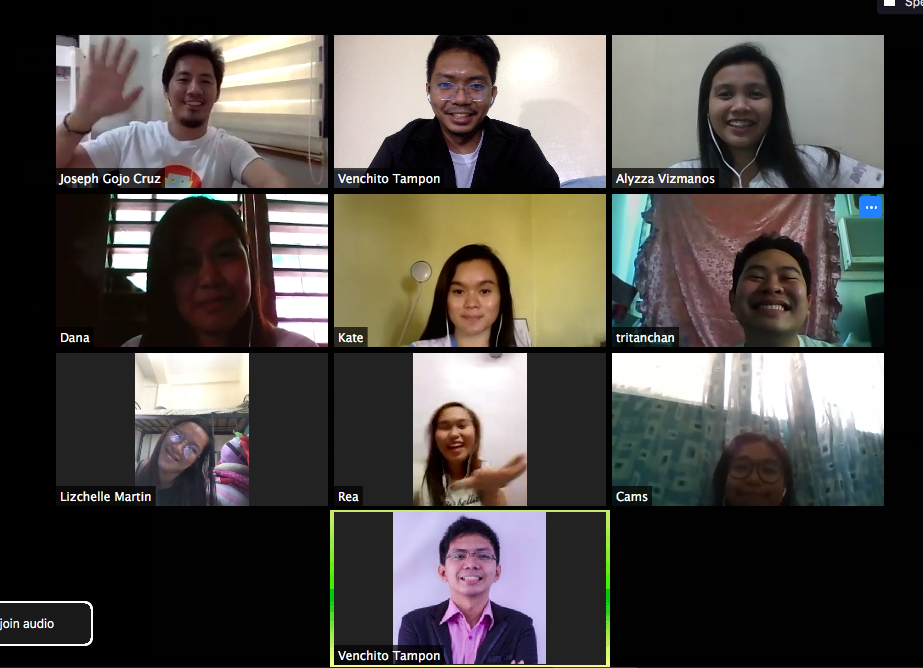

Through planning, you'll see methodologies for better work efficiencies and productivity.
Here are some tools you can use to manage work schedules and to delegate tasks effectively:
3. Conduct daily or weekly meetings
While you can't conduct in-person meetings with your team members (as what you do in-house), you can still effectively conduct online meetings with your subordinates.
Essentially, what you should be looking at here is proper schedules of 1-on-1 and team meetings without members sacrificing their time for prioritized projects and tasks.
Here are some tools that you can use to communicate and/or scheduled meetings with your team:
In communication, it's important to tell your team how and when they can reach you. There are urgent matters that have to be addressed properly, so giving your team your free schedules for interruptions help in addressing important matters quickly and thus, achieving target goals.
4. Address challenges and problems by providing solutions
There are minor and even intricacies when working with remote teams — that's not a surprise anymore. Weekly meetings with your teams and proper lookup of their current output give rise to many problems of inefficiencies and unproductivity.
You don't have to address them all at once. Identify problems that contribute negative impact on working performance and team culture. Provide solutions by asking your team for suggestions, as well as getting coaching and mentorships from other agency owners.
Here is a good webinar recently by Dev Basu of Powered by Search that addresses some challenges agencies face during a crisis:
Once you've identified challenges, the next step is to find any points of improvement.
These improvements can be implemented one by one. Then see which of them makes a significant impact to work productivity based on their expected changes in outcome.
5. Never forget training of your team members
This shouldn't be the last tip in this list of remote work recommendations. Training is ongoing essentials of an organization.
Without it, you expect plateau in growth, and could greatly affect your business' bottomline — if you're the agency owner.
Start with creating your training documents for your teams. It is best to have it available before work from home transitions. But regardless, you can spend some hours on top of your current daily work priorities to prepare them.
You can use Google Drive, Asana, Basecamp, Trello, Camtasia or Loom (for video recording) to prepare team training.
Here are some further tips to manage and develop your remote teams:
- Build morale of your team through pre-meeting conversations. Giving them encouragement and needed help to support non-work and work-related concerns.
- Get coached by agency owners who have extensive experience handling remote teams. This gives you new perspectives on things to adapt and apply to work from home functions.
- Address immediate employment concerns. Have it effectively conducted by your HR and admin team members, so you can focus on your priorities.
Further Reading:
Remote Work Made Simpler
I didn't say remote work made easy. Because it's not. However, by applying tips I've shared above, you'll be able to see increments of improvements to your remote team's productivity and work performance.
How to Create Brand Awareness Through Link Building
Brand building is the new link building.
Communicating your brand in a way that captures the attention of its target audience through quality content and community engagement.
You resist shortcuts and spammy link building tactics and focus more on thinking how your links can affect your brand value and brand equity.
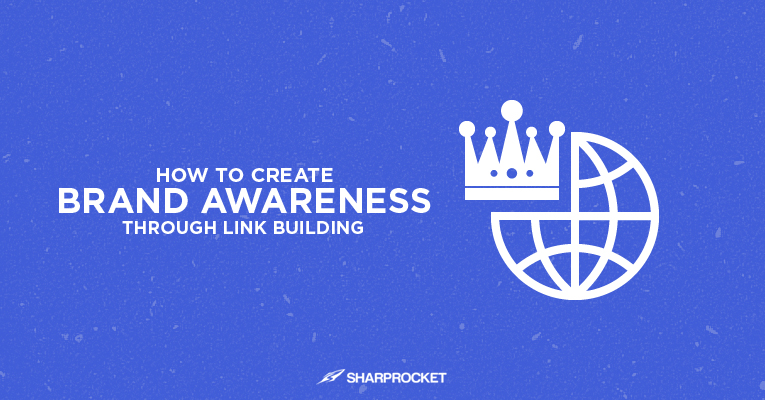

Table of Contents
What is Brand Awareness?
Brand awareness is the extent to which consumers are familiar with the distinctive qualities or image of a particular brand of goods or services.
Strategic link acquisition starts with identifying your brand's distinctive qualities.
On unique value proposition
A unique value proposition plays an important role in how you deliver your content assets to its intended audience.
If you can discover what your brand differs from its competitors — may it be in the total brand scheme or purely for content sake, you can easily emphasize the uniqueness of your brand or your content in all of your external marketing efforts.
Given that potential linkers receive endless pitches from brands looking to get natural links from people's blogs, linkers become more aware of what makes content on a particular topic unique and valuable.
They've seen different formats and styles of content for a particular topic. They knew what makes content different from others.
When you know your content's value proposition, it would be simple for you to create brand awareness around it. As you know how to position it to people who are likely interested in sharing and linking it, as well as improve the entire content asset for better information and value.
Importance of Brand Awareness
Fosters trust
You don't participate in any engagement of a brand if you don't trust them at all.
The same is true in pursuing links through brand awareness.
When people become more aware of the caliber of your content and what your brand stands for, as far as disseminating information is a concern, you gain trust from publishers and other content creators in your space.
Positioning yourself in the market
Getting a market share in an industry, particularly if your brand is just starting out, is never easy.
There has to be a strategic approach in building the authority and positioning yourself in the market.
Link building helps your brand gain momentum, wherein organic links become easier as people are starting to recognize your content every now and then. They link to your content pieces naturally as you develop your expertise in the market. Brand awareness does that.
Develops association
In building awareness, you gain new contacts and networks you never knew in the first place.
These are brands and individuals who gained a good understanding of your brand.
The more you build brand awareness, the more you become associated with influential people in your space — which primarily helps in gaining more exposure and secondary benefits of backlinks, social shares, and brand mentions.
Resulting to brand loyalty
The law of momentum starts to kick in. As you create awareness around your brand, you earn interest from people through the quality of your products and through the value-adding information of your content marketing efforts.
When this happens, you position yourself in the market and attract customers who will repeatedly buy into what your brand offers. This results in building new sets of brand advocates — resulting now to brand loyalty.
How to Create Brand Awareness Through Link Building
1. Strengthen your brand ambassadors
People connect to individuals more than brands. Brands don't have personalities unless a person or group of people from an organization speaks up — these are brand ambassadors.
In the idea of link building, brand ambassadors are people of a brand with a high level of expertise on topics they care about.
These are people who can go out and contribute something of value to the web community — may that be in a form of content, quality conversations on niche forums and community sites, and other initiatives that engages value.
Here are some brand ambassadors you can gain inspiration from:
Tim Soulo, Ahrefs - SEO Saas


Do you have to force your CEOs or founders to be brand ambassadors?
Definitely not. There are options you can choose:
- Opt to hire a thought leader in your space who can go on behalf of your brand — this could be an industry follower with existing huge following or someone starting out in the field but has extensive work experience.
- Start looking for someone who can build credibility through content contribution internally and externally of your brand assets (e.g. blog publications). It could be you or it is someone else.
Either you choose to hire an experienced influencer or build credibility for a potential brand ambassador. You need to strengthen him or her for more effective link building results.
How to build links by strengthening your brand ambassadors:
- Use expertise to build links. Learn how to use HARO and subscribe to the platform. Choose topics your brand ambassador has expertise in. Then deliver at best by answering questions with direct answers.
- If the brand ambassador is starting out, build his or her portfolio by contributing to mid-tier publishing websites, then go all the way up to niche high-end content publications
- Develop associations by engaging with past networks of friends with an online presence. Start sending emails or sharing their content on your social profiles to send radars on their signals that you're into the same line of industry.
2. Organize or sponsor an event
Events are a great way to elevate your brand.
Organize a public event. Either you do it for your brand alone or hire subject experts in your space to speak about topics they care about. Align topics into one theme and start an event.
Glen Dimaandal, a local and international SEO speaker produced several events on his own — PeepCon and SearchWorks which have become locally known for bringing experts in the search marketing and digital marketing field.


How to build links by organizing or sponsoring events:
- Set a name for your public events to get brand recall — for your participants to quickly remember when they see your events on different web places.
- Get authority links from event syndication and distribution websites. All it needs are your event details.
- Incentivize bloggers and content creators who are participants of your events. This is to get natural event reviews and/or mentions on their blogs — when this primarily depends on the quality output of your event.
3. Maximize podcast opportunities
Podcasting is mainstream nowadays.
Any content creator in industries that I know is thinking of ways to penetrate podcasts: either to start their own podcast or become a guest.
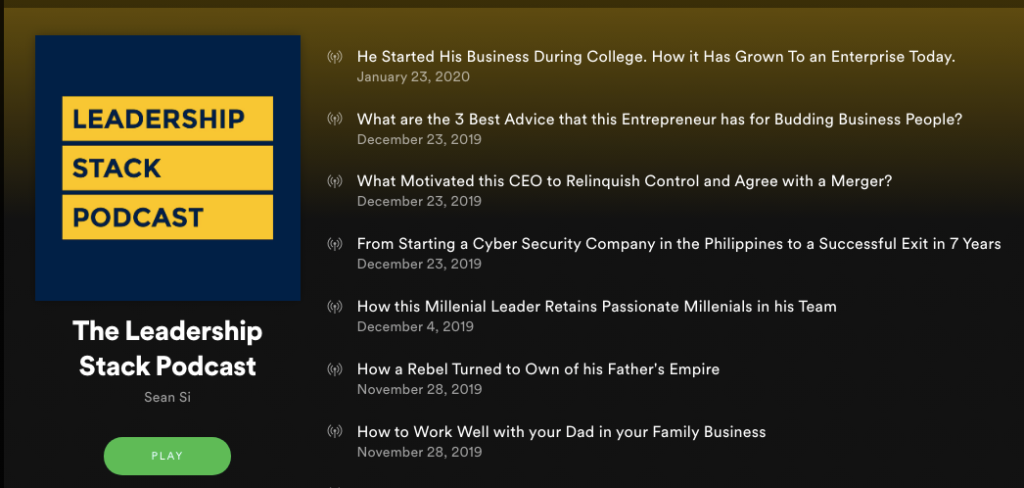

If you're trying to gain exposure by being guests on podcast shows, you can start reaching out to relevant podcasters.
I've covered the entire process of how to get podcasting link opportunities. But here are a few tips from the guide:
- Prospect for blogs hosting podcasts through discovery in iTunes search, Google search, and podcast directories.
- Organize your list with host/s name, contact details, and description of podcasts for easy customization of outreach emails.
- Choose a podcast show to pitch. Ask some assessment questions: Is this podcast providing external links to websites of guests on podcasts' footnotes or transcripts? Is the show focuses on discussing narrow or broad subject matters — is it a fitting topic to our brand? Is there a substantial number of followers on social and networks that can help us create more brand awareness after podcast guests?
- Pitch to become an interview guest. Share your portfolio and details on why you deserve a slot. Don't be too aggressive in followup emails. Here is a great post on how to send a follow-up email after no response.
Once you receive links to podcast interviews, start sharing it on your social profiles and to your email subscribers — to get a ripple effect of bringing in a new audience to podcaster's following list, while at the same, create awareness about your brand.
4. Create tools for targeted audiences
Content that creates both interactive and learning experiences gets the most editorial links, in most cases.
Tools are an example of this type of content. It helps audiences to do or to learn something specific.
A few examples of tools that work are:
- email signature generators
- privacy policy generators
- SaaS metric calculators
- blog idea generators
- invoice generators
- SEO checkers
There are so many other examples. Think of ideas by discovering problems no one in your industry has solved yet, or if there is one solution that has some features not catering to solving those problems you've discovered — you can take advantage of that.
How to build links to helpful tools:
- Start including descriptive links in your external content (e.g. guest posts) that previews your tool, if it's relevant to your post.
- Create short videos or how-to blog posts that showcase your tool. You can use Loom or Camtasia for video recording.
- Invest in community engagement by sharing a link to your tool page. You can exclusively give influencers in your industry early access to your tools. Exclusivity offers an advantage for more link opportunities.
5. Leverage influencer outreach
Start by reading why and how influencer outreach works in this guide.
Identify influencers who be will your key people of prospects for more brand awareness through link building.
How to make the most out of influencer marketing:
- Strengthen relationships with influencers, even if there are no opportunities for links. Don't let "for just links" mindset get in your head every time you connect with influencers. Adapt the "law of reciprocity" by offering too much value to a person that it helps you get residual benefits in return.
- Look for upcoming influencers as they are most receptive to press and interview requests, even product reviews.
- Categorize influencers as micro and nano influencers — you can check out this guide on how to do it.
- Collaborate content with thought leader content creators. You get the benefit of association once you do that.
- Interview influencers on your media channels (Youtube or podcast sessions). Once they share it with their networks, you create more exposure to your brand.
Think Brand Building
Think of branding when doing link building.
Always go for long-term benefits and initiate massively for building your brand. Through brand awareness, you start positioning yourself (your brand) in a way that you earn trust, respect, and tangible benefits, such as links and social shares.
Applied Attraction Marketing to Link Building
Without content, it's tough to build links.
Content ties the interest of the linker and your brand.
The content that has the highest value proposition to the end-user proves to get the right types of links.
Well, you can use content in two ways.
Reach out to a potential linker and offer your content as your value proposition. Your content matches the needs of their blog audience and in return you get a link. Success.
Or, create content that attracts links over time. Manual outreach is part of it, but because the content consistently attracts potential linkers, link building becomes almost automated.


Table of Contents
Attraction Marketing
We'll focus on the second — attraction marketing.
Attraction marketing is the process of drawing interest to a company, product or service using carefully devised techniques. The goal is to attract potential customers to the way the item has bettered the seller's own life.
When you focus your efforts on executing a strategy that attracts link opportunities for you, you get the most leverage.
While you can't choose which page links to you naturally, you can expect a consistent link growth for your pages with a link-attracted content strategy.
On Building Assets That Attract Links
Content assets must have its intended purpose. Creating content assets for the sake of fulfilling your editorial calendar is useless.
There is economics in a content-based link building environment we all have to consider. Links, as the main primary goal for an informational page, can have a secondary effect and value to the bottom line surface of the brand.
The right types of links will get your content to increase its search visibility for target keywords by making it rank better. But an additional secondary value to that is if those links can push further the secondary effects to the brand.
Attraction-driven links have high relevance standpoint
The right type of content attracts the right type of links.
When you compare links driven through manual outreach and links naturally acquired through ranking content for search, you can see different patterns of decisions.
For example, in manual outreach links, you can decide what websites or blogs to do outreach to.
From a relevance standpoint, if a team of link builders doesn't understand the relevance of links at its core, you run the risk of getting not-so topically relevant backlinks for your webpages.
Links attracted in any form have a higher assurance for relevance particularly from publishers who perceive your content worthy of reference. Content creators can be assumed to link only to sites and pages that are relevant to the information they're creating content about.
In general, links with more attraction marketing intent can have relevant links acquired that fit three important link factors: relevance, trust, and authority.
Links attracted push referral growth
Relevant links are likely to get clicks from its referring pages especially if those links drive click intent, such in the case for referential links. It gives an additional desire for the reader to look for more information.
If a content asset that ranks for search gets referential links from publishers, there is a likelihood of referral growth.
Given that those referential links can drive referral visits to their referring pages (your pages), you increase the odds of more content creators in your industry vying for more references. Chances are you multiply referral visits to your content pieces when you get more of this type of link.
Links attracted increases content's search visibility
With an initial solid manual outreach to get links to content, that page can rank for its target keyphrase. If keyphrase is referential in nature, when it ranks, it attracts more eyeballs from publishers who consistently discover updated and latest pages to cite on their own content works.
Attracted links can be turned into meaningful relationships
The law of reciprocity states a mutual exchange of value.
When you've been given a link by a publisher, there is an inherent desire to give something in return. While it may not necessarily be a backlink as well, you could perhaps send an email message with a thank you note in it.
Given that those recipients are actually the ones who link to in the first place, there is a built-in connection to respond to your email.
A subtle message for people who naturally link to your brand can lead to meaningful relationships, which then leads to more in-content links in the future.
Attraction Marketing Applied to Linkable Content Creation
When you build content pieces for link attraction, you think an end-to-end process.
From topic research to content's organic link acquisition activity, you ensure every step is tied into every other step.
A well-thought initiative for topic research, for example, should perceive the right audience for outreach, when it's content promotion time.
Every activity in the way must be well coordinated to ensure a much larger success in the campaign's end results.
A. Find referential topics or source-to-cite queries
Content strategy starts with ideation or getting blog post ideas.
Generating content topics for a specific purpose is vital to the success of the content marketing campaign.
For an attraction marketing-driven campaign, you want to find topics that have a chance to earn links from publishers.
These are normally referential topics or source-to-cite queries.
Content creators refer to valuable pages by citing them on their blogs.
Before diving into topic research, it's important to understand why people are actually searching for (even linking to certain pages) for additional references.
1. The difficulty of defining, describing, and explaining the topic
Is there a demand for the keyphrase to come back again for another time and search for that same keyphrase again?
Think about it. If a content creator wants to know what this jargon means because it's difficult to explain it in layman’s term and may require definition from a credible author, it has a chance to be included in another content piece by directly linking to the source page.
This is an initiative of content linking to the definition of a technical term as it gives the entire overview of what the phrase means.
While you might be aggressive about this and try to create your own definition of every technical term and publish them on your site, it's important to understand the difficulty as well as the demand for the keyphrase.
Other examples are concepts that can't be published by non-practitioners. Any new industry concepts require technical expertise to explain it clearly to its intended users.
IIf your brand can simplify a concept to be better consumed by its target audience, this makes the topic feasible to attract potential link opportunities from publishers.
2. Ease or convenience
For basic applications that demand more attention and time to create is an opportunity for content creators diving in the attraction marketing idea.
Here are some examples of the type of content that aids people to create content for personal purposes:
Rental Income Expenses Template (SPREADSHEETS)
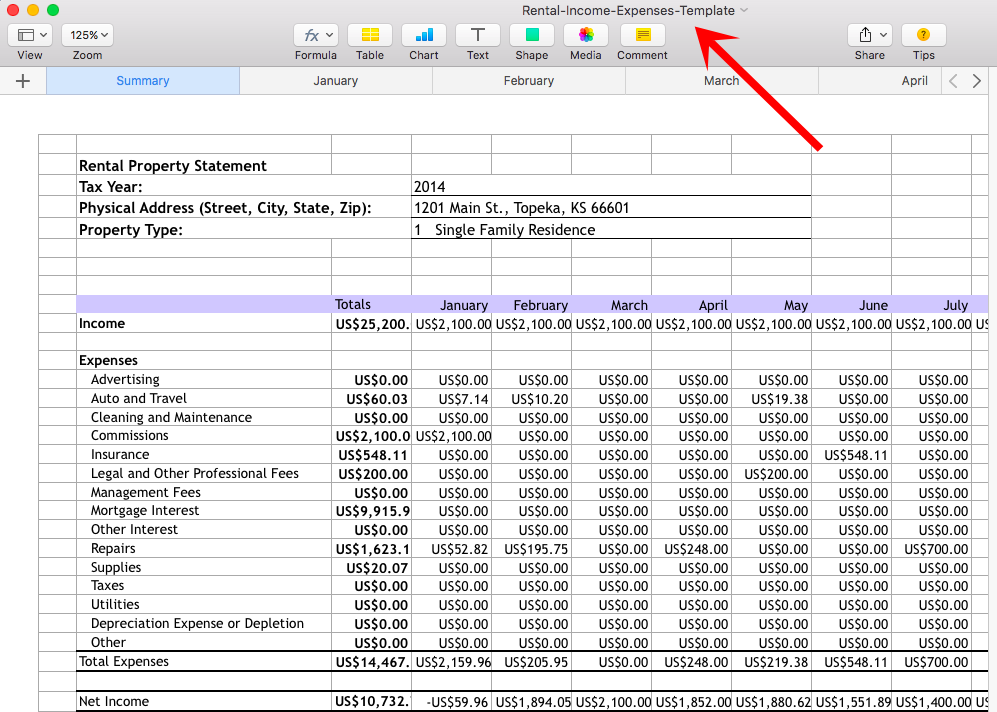

MBA Recommendation Template (RECOMMENDATIONS)
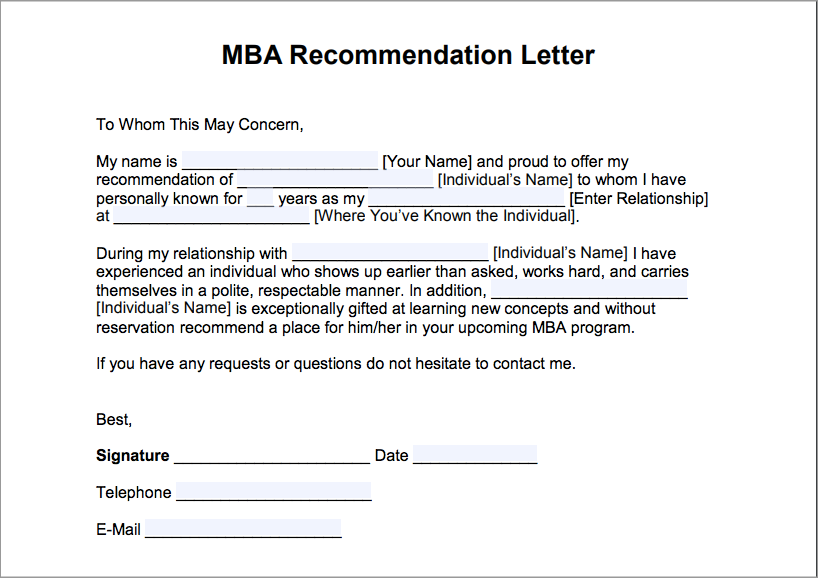

Other types of templates:
- letter template
- estimate template
- proposal template
Most of this type of content would be more useful if they can be customized immediately. PDF forms uploaded to websites require more friction as it needs to be converted to an editable file format.
Regardless, sample content pieces with editable sections are topics to consider for an attraction-driven linkable content.
3. Additional credibility for content
Referencing valid external sources increases the credibility of the content.
Topics of a survey, data, numbers, and statistics have high possibilities of linking as they are deemed necessary to make a content piece updated, relatable, and credible.
Finding Source-to-Cite Queries
Look for any queries that fulfill the aforementioned needs:
- the difficulty of defining, describing, or explaining a topic
- ease or convenience
- additional credibility for the content
Discover any of these source-to-cite queries in your industry:
- statistics
- data
- template
- letter
- sample


It is best to look at the current linking patterns of the top-ranking pages for your preferred queries. Here are things you have to consider:
- The average number of unique referring domains of currently ranking pages for the query
- Type of links (citable, branded, etc..)
- Link placement
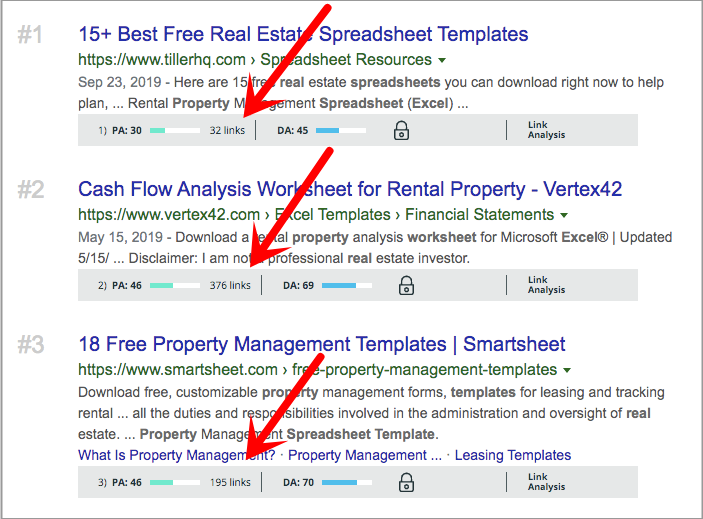

By having those considerations, you can then estimate a good number of links to expect when the content ranks for the query.
B. Use manual outreach to acquire initial links to rank for those queries
The competition of the search for the key phrase matters whether you can easily rank for it or not.
If it happens that the keyword difficulty is too high and the ranking pages have more than 50 or 100 links attached to them individually, it will require a massive outreach campaign to even get the page 2 or 3 ranking spot. That's the reason why it's important to study the topic of competition. The question you need to ask, "does my site have enough authority for my new page to rank for the query?"
That being said, investing your efforts into initial manual outreach is needed to get the initial backlinks to rank for source-to-cite queries.
From the Future agency recently launch a useful tool that can semi-automate the promotion process of a content piece.
It solves that one overlooked simple strategy in content promotion — which is basically reaching out to all brands, sites, and publishers you've mentioned on your page.
Given that, if you can reach out to these mentioned content creators, there is a reciprocal benefit you can gain in terms of a link, mention, or social share of your content piece.
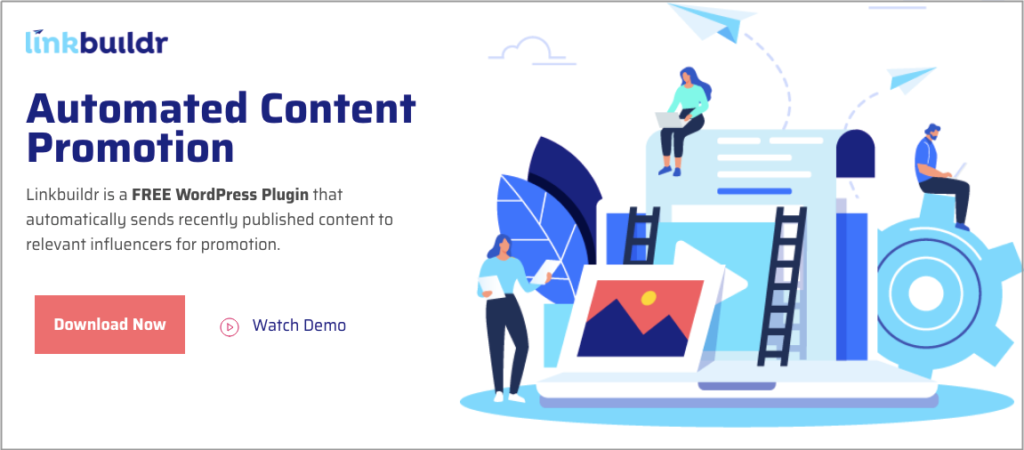

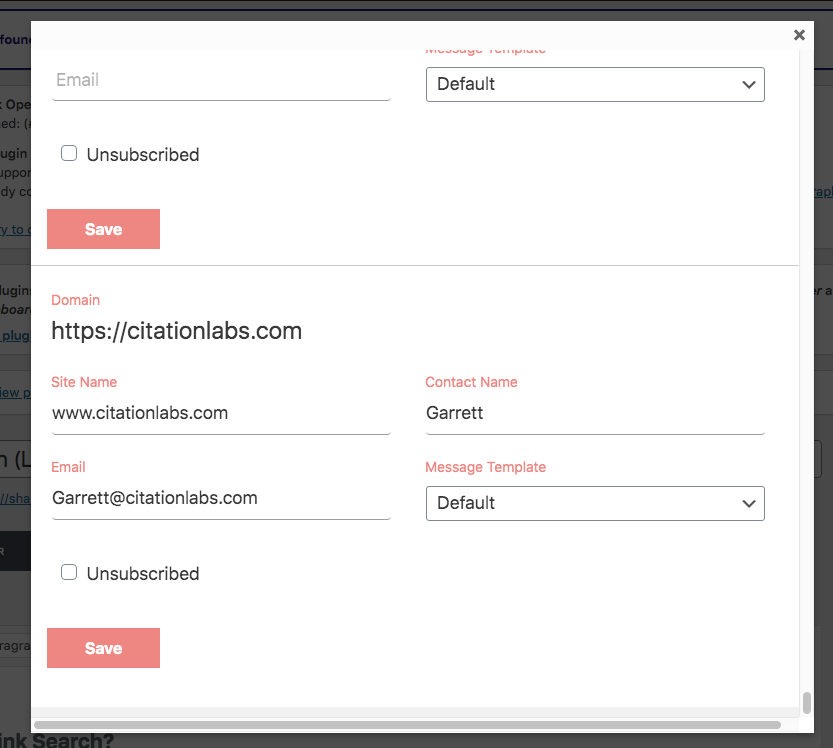

You can also reach out to publishers who've linked to content assets similar to yours. Discover those linking pages using Ahrefs in two ways:
- Use Backlink Explorer to find all pages linking to a similar content
- Use Content Explorer to find highly related pages and discover links to them
The leverage to push the content to dominate the first spots for a source-to-cite query is certainly difficult.
Your results depend on the quality of your content and the relevance of your link prospects to your page.
The moment the page dominates the top spots for the query, you can expect links from people who've used your content as a reference to their online works. The more links you get from this almost automate the process of link acquisition, the higher it'll climb to the top of the search.
C. Use optional paid advertising to build more momentum
Another way to build up the content higher in rankings is to spend a minimal amount of money on advertising (~$100).
There are two advertising options you can use: pay-per-click and Quora.
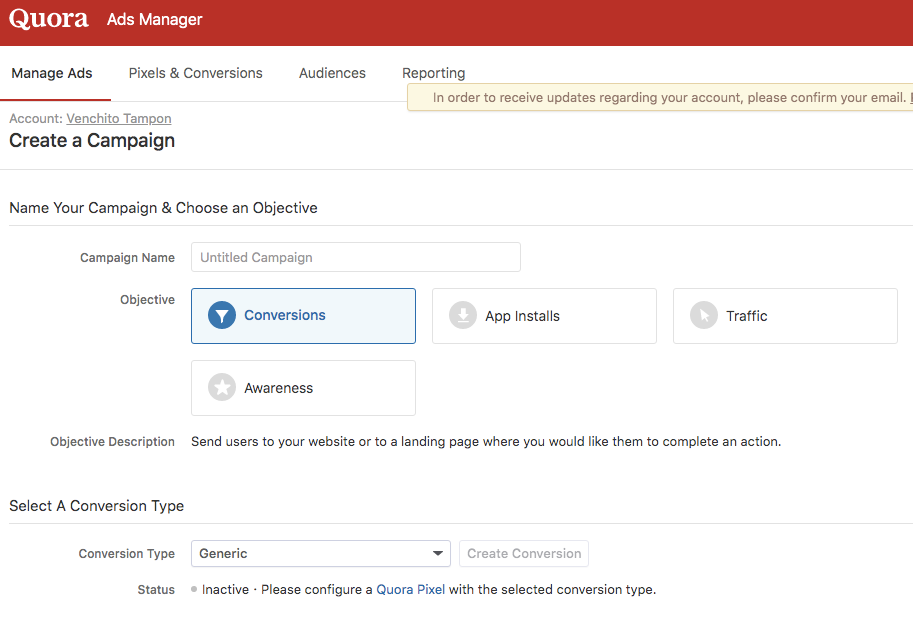

Depending on the cost per click for the query (for PPC) and the number of possible visits from Quora, you put more eyeballs to your web asset, which then leads to an increase in search visibility for the query.
Google paid advertising also gives you the leverage to first be seen when people search for the query. This means they have more chances of consuming and eventually including in their publishing initiatives.
D. Use Aware or Ahrefs to monitor links and mentions
Use tracking tools to monitor any new links to your source-to-cite content piece. By doing so, you can check the advertising spent or the return on efforts you gain from doing the initial manual outreach.
There are secondary effects you might miss out if you focus alone on bare link metrics. Try to monitor or at least look at the next set of links after you rank for the query as well as the relationships you've built or might have built during the process of content promotion.
Build Momentum in Attraction Marketing
One attraction marketing method is to let people come to you because they've known your brand.
While that's easy to say, it's not a reality for many brands online. Some of them must build the initial momentum to get the initial visibility in order to attract people they expect to have for their website - whether those are link opportunities or branding and relationship networks that can scale the online business.
Whatever it is, build momentum first, then leverage on what words for content promotion, and start seeing results from both branding and link perspectives.
43 Experts Share Their Most Actionable Link Building Tip
Link building is one of the essential and time-consuming activities in search marketing. It can help websites lift up their rankings in search results and can also enable brands to reach their business-related goals (i.e. increasing conversions through referral visits).
The approaches used in link building to target those goals vary depending on the type of industry the business belongs, the level of competition in the space, available resources that can be used by the online marketing team, and many other factors that can affect the success of a specific link building campaign.
To help us perform better in our link building tasks, here are the 43 link building experts who'll share to us their most actionable link building tips.
Link Building Tips from Top Link Building Experts
Experts have a lot of experience in the link building arena. Their mistakes and learnings would give us insights on how we can improve our link building campaigns. So let’s hear from them...
Here is the question that I sent to 43 link building experts.
“What is your most actionable link building tip?”
And below are their answers…
TL;DR
- Create Something Fun And Be Consistent
- Leverage Competitive Brand Mentions/Links
- Stop Reading About Link Building and Start Doing It
- Use Visual Assets to Build Links
- Build Links to Improve Domain Authority
- Look At The Engagement and Build the Right Relationship
- Seek More Linking Opportunities
- Create A Crazy Product
- Compare Backlink Data of Top Competitors With Your Own
- Get Testimonial Links
- Remain Compliant With Search Quality Guidelines
- Improve The Strategies You’ve Used In The Past
- Create Quality Evergreen Content
- Use Google Image Reverse Search for Image Link Buiding
- Use Preciprocation To Your Link Building Campaign
- Use New Products/Services/Features to Create A Healthy Link Profile
- Create Stuff That Will Resonate To Your Audience
- Build Relationships With Bloggers Through Guest Blogging
- Personalize Outreach Emails To Generic Email Addresses
- Go and Make Your Website A Great Experience
- Always Implement Strategic Planning In Your Link Building Campaign
- Get Links With Partnerships
- Don’t Ignore Broken Link Building and Link Reclamation
- Do a Groupon
- Take Advantage of Missing Image Attribution
- Cause Friction in your Market Place
- Link Out Generously
- Participate in Forums
- Reach Out to the Right People, About the Right Content
Table of Contents
Create Something Fun And Be Consistent - Chris Dyson
With Hit Reach, we have been trying out lots of new ways to create content that will gain links naturally to our site. A lot of businesses I have worked with in the past are afraid to create content that's a little outside the box and does not fit within their corporate brand message, sadly 99.9999% of people on the internet couldn't care about your stuffy brand image and want to link to photos of cats or something fun.
Our biggest experiment of the past few months was to create some comic strips based around a fake digital agency "Digital Rockstars", at first it was difficult to come up with ideas but now they take very little effort to come up with as we produce them week in week out. The comics are released under a Creative Commons Attribution license so anyone can use them - all we ask for is that you credit us as the source.
So far we have published ~24 comics and earned links from places such as Ahrefs, Search Engine Land and various other marketing blogs with no outreach, except for sharing the new comics on social media.
According to Ahrefs, we have 130+ links to these comics...
I'm sure if I checked image raider or Google image search I would find a bunch of other sites who haven't linked and used our comics.
Initially, we only produced one comic per week but we're now publishing 2 comics per week due to the increasing popularity.
In 2014 we plan to create more topical comics relating to changes in the digital industry and hopefully re-purpose these comics into presentations at conferences and guest posts.
Leverage Competitive Brand Mentions/Links - Rand Fishkin, Sparktoro
The combination that I find most actionable and immediate for link building right now is leveraging competitive brand mentions/links and mentions of your own brand that haven't linked. I know it's self-serving, but for both of these, I love Fresh Web Explorer right now. I can do a query like this: "rand fishkin" -rd:moz.com and see a list of pages that have mentioned me, but failed to link to my site. Contacting them an asking for attribution is a great way to get a lot of high quality, editorial links.
Stop Reading About Link Building and Start Doing It - Nick Leroy
My most actionable link building tip is to stop reading about building links and to start DOING it. Reach out to bloggers/resources in your industry. Offer your time, resources or in some situations money to secure the best links in your industry. Also, make sure to pick up the "easy" links by scouring your competitors' backlinks. Get as many of the links that they have and then build even more!
Use Visual Assets to Build Links - Gregory Ciotti, Sparring Mind
Frankly, I'm in full agreement that 'visual assets' are the way to go with link building today. I've used animated video, such as my Science of Productivity video collaboration (1.2 million views) to build hundreds of links, and I've seen the same effect with other more static visual elements. The reason being, infographics take up a full post if someone wants to re-post it, but a small chart or illustration can be included in a longer piece to strengthen the author's point. I've seen the charts from places like the OKCupid blog passed around to literally thousands of people (via other blog posts and communities like Reddit). Think of opportunities to show people instead of telling people, and you'll be on your way to creating an image that's bound to get passed around. As an example, here was a highly controversial (and extremely popular) image from OKCupid on how your race affected your average response rate on their online dating platform:
Imagine trying to disperse that information with words alone: it wouldn't have worked nearly as well. That is where the power of visual assets lies, you needn't rely on a gaudy infographic to enhance a piece of information that people are likely to share.
Build Links to Improve Domain Authority - Jason Acidre, Avaris
"Instead of just giving you one actionable link building tip, I’ll share 22 (plus one) tips that our team has learned this past couple of years doing intensive link development campaigns.
These tips were originally published as a blog post here, but I thought of transforming the post into a slide deck to make it easier for the readers of this possibly gigantic crowdsourced post.
Look At The Engagement and Build the Right Relationship - Peter Attia
This question varies depending on the industry and its needs, but one that I’ve found to be pretty universal is to find a community to be a part of. I don’t necessarily agree with the whole “Build relationships, not links” movement, as it’s more about building the “right" relationship. For example, if you do a co-op post with someone who’s a leader in their industry, you’ll get noticed by thousands of people who are part of their community. This will give you the opportunity to get way more links, as it also gains your trust. People who see an industry leader trusts you, are more likely to trust you themselves.
I think that’s important to keep in mind when looking for new blogs to build links to as well. Instead of making sure your link is put on a site with a certain MozRank or a minimum number of backlinks, look at the engagement. A blog that gets a hundred comments on every post has more potential than a blog with good backlink stats. There’s a chance to build new relationships, get real conversions, build your brand awareness, and show real engagement through social media.
Plus, a blog with a large audience will likely get better stats in the near future. It’s always easier to get a link on a blog before they realize how valuable they actually are. And again, if you’re part of a popular community early on, you’ll instantly be trusted by any newcomers to that community.
Seek more linking opportunities - Venchito Tampon, SharpRocket
The most common scenario when doing link building is to find a page that is primarily targeting the goal of the campaign. For instance, you have a great resource on your site (e.g. ultimate guide to...) and you want to build several links to it. Usually, you will use the advanced search operators to find resource pages that are linking out the same type of content that you have (resource type). Then use the Link Miner to find broken links on the page and list down any defunct link in the spreadsheet (if you see one).
And it ends there...
Now, you have to take another route. Instead of only aiming for one link (link from the resource page), you may also want to seek for more linking opportunities from the site. Visit its blog section. Determine if the webmaster provides guest posting opportunity to its community (simply using this advanced query: site:domain.com "guest post" OR "write for us"). Check also if the site has a sponsorship page with external links to sponsors' websites. If you have a small budget for this, you might want to contact the webmaster and sponsor a physical product or money instead.
Why this strategy works?
- The more you see linking opportunities from one website, the more you engage with the webmaster. The higher the engagement, the stronger is the relationship that you build with the person.
- It semi-automates your content promotion activity. Given that you've built strong relationships with a few people, they can easily help you market your brand/content (this is good especially if they have a large number of social followers and/or brand advocates).
- Followers of your prospect site can remember your brand (since your content is always being linked out to by the site owner).
Link building should be strategic in any way. You have to be creative when seeking for more linking opportunities from one website.
Create A Crazy Product - James Norquay, Prosperity Media
To gain great links in today’s market you need to be creative. At the end of the day, it is not just about links you also need to think about brand mentions, traffic, and sales. One of the most actionable ways you can build links to a website is by creating a buzz with your brand by selling a silly product. It can be real or fake with the idea of building links in mind. One brand which does this VERY well is an Australian brand called Kogan.
In the last week, Kogan launched a new product called “The ZukerbergSelfie Stick” see product below (you can actually buy this product)
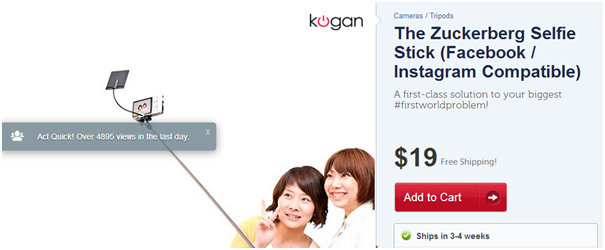

The interesting thing about this product is that big news websites have picked it up and most have linked back to the brand website or product page. In total around 26 news websites have linked back.
Example of links they have gained from this product launch:
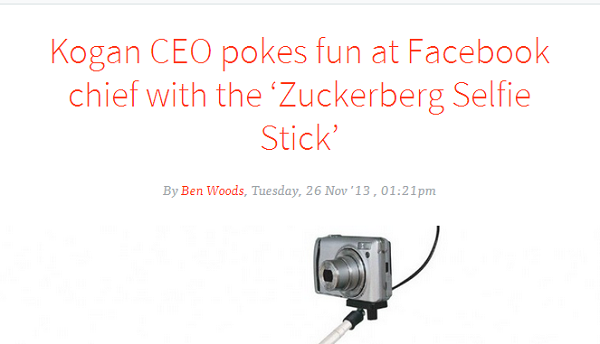

Now Kogan is not the only brand playing around with this type of strategy to gain links, PR and brand mentions. Another company Power House Fitness in the UK have also ran campaigns where they launch silly products, I have written about this company in the past on my blog to show the types of strategies they use to gain links –
So that is my tip.. build something different for your brand with an aim on generating buzz, PR and links.
Compare Backlink Data of Top Competitors With Your Own - Harris Schachter
One thing I like to do which is not only actionable but also a key first step in any campaign is to compare backlink data of top competitors with your own. Using link building tools of choice, grab the data on your competitors for your target anchor category (i.e. not a single exact match term but rather a group of variants which I call an anchor category). Put this competitive data in a spreadsheet alongside your own for the same anchor category and pivot to find sites linking to competitors but not you. If you find domains linking to more than one competitor, chances are good that you can get one too.
Get Testimonial Links - Benjamin Beck
Think of the services you appreciate and use. Check to see if they have a testimonial page that links out. If they do, offer your testimony to be added to their page. Please only give testimonials for companies that you actually use and can positively review.
Convert Non-Linking Brand Mentions Into Links - Simon Person, Zazzle Media
Right now we are getting a lot of traction tracking web mentions and then following up on non-linking brand mentions or mentions of the expertise for which our client is famous for. With some good PR follow up you can usually convert that into a 'link' and add some extra value to the piece they have written, so everyone wins.
We do this using two key tools - Social Mention and Fresh Web Explorer by Moz. We will set up a brand and 'expertise' mentions and monitor this daily to ensure our PR team can jump on it while it is still relevant and fresh in the mind of the writer.
Remain Compliant With Search Quality Guidelines - Chris Ainsworth
If you’re talking at a beginner level then my must actionable link building tip would be to ensure you remain compliant with search quality guidelines. Google especially are continually evolving their perception of links and refining guidelines accordingly; so ensuring you do not participate in schemes which breach search quality guidelines would obviously be my first point of call. Following that, I’d recommend investigating areas in which links can be acquired quickly and relatively easily. Businesses can often leverage valuable links from suppliers or partners which often get overlooked by other, arguably more advanced, techniques such as guest posting. Always start with the basics!
Improve The Strategies You’ve Used In The Past - Wiep Knol
Take a good look at your current link profile and pay close attention to both your best (as in high quality) incoming links and your most popular pages. Try to analyze *how* you got these links. Was it a specific contact, was it highly targeted content, just plain luck, or something else? Learn from your own successes, improve the strategies you’ve used in the past and try to get even better results as the last time. You don’t have to invent the wheel twice, just make sure you keep improving it.
If you’re starting from scratch, you can also take a look at the most linked-to content of your competitors for some content- or strategy inspiration. However, since you’re missing a part of the picture, fully analyzing the processes and critical success factors isn’t possible. But it can still be fun to do.
Create Quality Evergreen Content - Garrett French, Citation Labs
My tip is simple: create quality, evergreen content to pave the way for effective, meaningful outreach and the highest possible quality links.
That said, "quality content" is always a moving target and differs from vertical to vertical. Each vertical has its perennially important topics and you have to drill down into these - and investigate their linkers - to be sure that you're creating something that's going to perform well at the outreach phase.
Also complicating the "quality content" issue, the content you are capable of creating will differ if you're operating as an agency or as part of an in-house team. Inhouse you will have far more access to internal knowledge resources and will know the ins and outs of getting something published on your website. Agencies will have more trouble mining out all that internal expertise but are likely able to get content done more quickly... plus have an innate sense of what will or won't incent links.
So within my tip to create great content (yes it's a tired old tip) there lies an important, under-discussed reality. Each vertical has distinct linkers - sometimes its link list curators, sometimes news bloggers and sometimes both. Each vertical has its distinct "evergreen topics" that, if created well, will always earn links. Know your linkers. Know your vertical's key topics. Then you'll never have trouble building links.
Use Google Image Reverse Search for Image Link Buiding - Paddy Moogan, Aira
I'd recommend using Google image reverse search to look for websites that have used your images, logo or pictures of your staff on their websites but haven't linked to you. Then you can reach out to them and ask for a link because they've used your images.
Use Preciprocation To Your Link Building Campaign - Brett Snyder, Nebo
When we talk about actionable link building tips, I actually prefer to keep things simple and make sure that the tips are truly actionable for marketers regardless of experience or size of the client. That said, my most actionable tip is actually something that was written about a lot probably 3-4 years ago and that is the concept of preciprocation. You may very well be familiar with this but this can apply to any link building campaign, at any budget, in any industry. To summarize, preciprocation means identifying your desired link partners (the people you think will be interested in linking to you) and getting buy-in from those link partners before you have an asset that you're trying to get links for. This strategy can take many forms, depending on the asset. For example:
- You're running a campaign to raise awareness about an event, reach out to people who participated in similar events in the past and find out what they liked/would have done differently with those events
- You're creating a content asset, identify subject-matter experts in the field and see if they would be interested in collaborating on the asset
- You're publishing a research-focused piece, reach out to the sources you're using and ask if they have anything to add beyond what you found in their original source
The key premise here is that you want to build a relationship and offer something to these potential link partners to get them invested in your campaign. The goal here is not even to get links, it's to get them invested. Once you have someone personally invested, they are much more likely to do what you ultimately want (link to it, share it via social, etc.) but you're not simply using them to promote your asset. Everyone in SEO talks about relationship-building as the key element to link building, this preciprocation approach simply pushes that relationship-building aspect to the very front of the process and lets you stay flexible to fit your asset around that relationship (instead of the other way around).
I know this is a very long response so if you feel it adds value please feel free to edit as you see fit. If there's anything else you need from me you now have my direct email so please don't hesitate to reach out anytime.
Find What Links Your Competitors Have That Your Could Potentially Acquire - Geoff Kenyon
If you are working on promoting a new product or brand, Moz's Link Intersect is a great tool. The Competitive Link Finder is really helpful for finding what links your competitors have that you could potentially acquire. It's really easy to use too; you just put in your domain and some competitors and Moz will use their OSE data to see what links multiple competitors have and gives you a report. The Link Acquisition Assistant automates 121 different queries to help you find links - a lot of these results aren't the highest quality (such as directory sites), but you can usually find some good ones here.
Use New Products/Services/Features to Create A Healthy Link Profile - Carrie Hill, Ignitor Digital
Links now are about more than just a website linking to your website. They're about content and context. We encourage our clients to use new products, services, features, and even community events to create a healthy and sustainable link profile.
If you're a doctor, providing free flu shots to teachers in your school district, or holding a health clinic for a large company's employees can get you some good press, and some great links.
If you're a computer repair firm, work with local non-profits and churches to keep their equipment up to date and working well. Establish a great relationship and offer great service, then ask for a link from their website. You can also do this with area private or charter schools as well.
Create Stuff That Will Resonate To Your Audience - Gianluca Fiorelli, iLoveSEO
The best thing is creating stuff that will resonate with our audience and have it promoted by someone who has a clear influence on them.
In order to find the most potentially viral idea for content, I usually simulate a Facebook ads, indicate as main interest the one related to my site and analyze others interests my targeted audience have... and create the content based over the most "short-circuited" interests, using the "random affinities" principle Ian Lurie explained very well in many of his posts and speeches.
For instance, a site sell insurances and its targeted demography are interested also in Star Trek? Hence, why not creating a fake product "Starfleet Spaceships Insurance"?
Better if we are able to involve the Star Trek official website in this operation from the beginning, because they have a huge follower base and community, so that when we launch the campaign we can have the biggest social echo and, from there, earning also links but, especially, brand visibility and organic traffic.
That's the kind of tactic I suggest, and it can be replicated in almost every niche and case.
But what I care the most are not the links (well, they are obviously welcome), but the organic traffic those links may generate.
That's what I consider safe link building.
Build Relationships With Bloggers Through Guest Blogging - Miguel Salcido
Honestly, the most actionable thing that a business owner can do to gain powerful links is to guest blog. Authentically. Use a real name and face and connect with bloggers in your niche and build relationships with them. Real relationships. Invite them to post on your site too! This is also a great way to gain access to other relevant audiences. It's difficult to do for direct competitors so look to build relationships with products and services that compliment or are parallel to yours. For instance, if you run a local cleaning services company, connect with local real estate agents and local business organizations (for commercial cleaning).
Run An Analysis of Competing Websites - Daniel Law
This strategy is one of my personal favorites and all credit goes to Paddy Moogan who works at Aira.
Using Screaming Frog, run an analysis of competing websites and jot down a list of all their 404 Not Found pages. Depending on how well their website is maintained they might actually not have many 404s, but more than likely you're bound to come by a few.
Once you've compiled your list, run through the 404 Not Founds through a backlink checker. I recommend using Ahrefs as their index is updated the most frequent. Scan through the list of backlinks and drop an email to the webmasters of each domain kindly notifying them that they're linking out to a broken page. Kindly suggest another HQ and relevant piece of content (preferably your own) to take its place.
This is a great strategy in building quality links as well as assisting fellow webmasters quality control their own sites.
Personalize Outreach Emails To Generic Email Addresses - Brian Dean, Backlinko
My most actionable link building tip is to personalize outreach emails to generic email addresses.
Let me explain:
If you do a lot of email outreach you'll ultimately have to send at least some of your pitches to generic
emails (or even worse) contact forms.
Because this is the equivalent of sending your message into a black hole, many SEOs skip over these targets and move onto one where they can send a message directly to the recipient.
But to me, that's a huge mistake.
What I do is send me a message to the generic email as if it's to a specific person.
So if I know Jane runs a page or writing an article -- but can't find her email address -- I'll send a message to support@example.com like this:
Hi Jane,
Just wanted to say that I loved your latest article about X.
However, I did find a few broken links...
Yadda, yadda, yadda.
Cheers,
Brian
When you look at it from the person who reads those support@example.com emails, that's an email that he or she feels compelled to forward to Jane (in fact, it's their job to forward that message).. But sending a message that says something like "can you please forward this to the right person" is going to get deleted instantly.
Go and Make Your Website A Great Experience - Alessio Madeyski, Digital Hothouse
Go and make your website a great experience, tell a story every day, every week. Mention other websites, other companies (maybe not competitors) and then collaborate with them. Do something for someone. For example, we all need schools to suck. Why companies are not spending money (and sometimes you just need to go to a school near your HQ) to inform and do workshops with students? Like: you are a plumber. WOW! Why you don't go to schools and university teaching some tricks about plumbing?
I guess what I wanna say is: don't do anything on your website just for having links. Do it because you like it and enjoy it, and if you want links, well...they will arrive. The best time I have these days is with a tourism-related company that has a section on their website where they are telling stories mentioning museums, libraries, and spots to see. There you can contact for example the museum mentioned saying: hey, we mentioned you as a must-see during our journey to wherever!. But I'm doing it because I think it's a great idea, and the museum should be happy. If the museum is gonna give me a link back, all the better.
We need to focus a bit more on the beauty of doing things. Otherwise, everything is much more difficult.
Always Implement Strategic Planning In Your Link Building Campaign - Bill Sebald, Greenlane SEO
My best tip for link building is to schedule a block of time to sit down (possibly with your team), take inventory on what your client or business has of value (whether it’s an asset, service, or product), and think about what different types of audience could really care about it. Then think about the tactics you have at your disposal. This is where you start if you want not only links that help your SEO, but links that can send qualified traffic. I think sometimes we go in headstrong with just tactics and don’t do the required upfront work to really make each and every outreach more valuable. Basically, my most valuable link building tip is “strategic planning.”
Reverse Engineer Your Competitor’s Backlink Profiles - Rohit Palit, Techtage
My most actionable link building tip would be reverse-engineering competitors' backlink profiles. There are many backlink checkers out there, but Ahrefs pretty much blows the competition out of the water. You can never rely on a free service for a serious backlink reverse-engineering campaign, so I'd recommend at least Ahref's professional plan which costs $79/mo. It might sound a bit high, but the ROI definitely makes up for the expense.
What I tend to do with most of my campaigns is:
1. Find and identify sites within a particular niche that are performing very well in Google.
2. Explore their link profiles using Ahrefs.
3. Come up with a list of referring domains and referring pages that I might have a chance of getting a link from.
4. Do what I'm supposed to do, trying to replicate those links for my own site. For example, manual email outreach, guest post submission, relationship building, etc.
I only choose targets that I know will be very likely to link to my site because they usually link to similar ones. I make sure that my own site has content pieces that stand out from the competition, so it's a lot easier to attract links to them.
And this tactic didn't only give me a dozen cold links, I also got to know a few people with whom I still maintain a good level of professional relationship because of Ahrefs. Seriously, there are endless possibilities once you start looking through referring domains of a site on Ahrefs. It opens up a whole new world in front of your eyes. Think about a parallel (to search engines) system to find more new and interesting sites on the inter-webs.
Though it varies from campaign to campaign, I get around 25-50% success rates, so you can consider this strategy bang for both buck and time.
Leverage Guest Blogging To Build Relationships and Earn Links
I wish I could say "guest blogging" but I advocate against approaching guest blogging as a link building tactic. Guest blogging is good for building relationships and seeing links coming from that as a result, not vice versa. So I guess I don't know any "actionable" ways. I talked about that at Pubcon Vegas, so you can see my way here:
Identify Your Online Assets That Are Link Worthy - Tony Dimmock
Before hunting for links, ask yourself: “What online assets do I have (or need to create) that would be link-worthy?”
In my experience, many businesses fail before they even begin link acquisition campaigns, because they don’t take the time to understand what is “valuable” in the eyes of their website visitors and target audience.
To avoid this happening to your business, answering the questions below will reveal the “who”, “what” and “where” of your online asset strategy:
1) Who is your target demographic?
- Think about the age range, financial status, typical mindset, education and what “floats their boat”
- What are their needs, personally and professionally? Think about the problems or challenges you help them overcome
- Why do people buy from you? Asking or surveying your audience is a great way to find out what they think about you and what you offer
- What information is important to them? Finding this out will help you create content that entices them to link to (and share) your content
2) What content can you create, that doesn’t currently exist?
The opportunities to connect with your audience in your field are endless. To show your authority in your niche, could you create any of these?
- First-of-its-kind industry whitepapers that explore hot topics that no-one else approaches
- Embeddable widgets, videos or tools that solve a problem many face daily
- Real-life accounts of how existing customers used “x” to reduce “y” and gain “z”
- Competitions with prizes that entice users to share creative ways they used your products or services
- Interviews with market influencers or thought leaders that offer new perspectives or ideas
3) Where can you find influencers that will link to or share your assets?
Online and offline, try approaching these:
- Industry trade associations that your assets connect with, that provide value to their members
- Event organizers that run meet-ups where your target audience discuss topics relevant to your assets
- Journal and magazine editors who run seasonal features that your assets offer new perspectives on
- Subject-matter bloggers who research and write about topics within your niche
- Journalists who search for news, views and opinion contributors
Get Links With Partnerships - Steve Morgan
I work with quite a few small local businesses who may be long-established but are completely new to marketing themselves online. One method that I always prioritize is whether they have any accreditations or belong to any associations, as often it can be very easy to get a link and they're often authoritative websites. For example, I work with an IT support company that partnered with Microsoft (DA100), Cisco (DA98), CompTIA (DA83), Dell (DA94) and HP (DA96), some of which allow their partners to have a profile with a link. My client had done some of them but not others, so it was a no-brainer to look into doing these first.
Leverage Your Content to Build Links - Larry Kim, Wordstream
I wrote up my most actionable SEO tips as case studies, here:
We’ve used these basic strategies to get hundreds of thousands of links in the last few years, no kidding!
Don’t Ignore Broken Link Building and Link Reclamation - Steve Morgan
My most actionable link building tip is simple: don't ignore broken link building and link reclamation.
Both of these techniques are very successful, but for whatever reason, a lot of sites completely ignore them in favor of "sexier" approaches that are much less efficient.
Broken Link Building
This link building technique is typically a 3-step process:
-
- Identify pages that have broken links (i.e., links to other pages that are no longer accessible).
- Find contact information for the webmasters responsible for maintaining those pages.
- Contact those webmasters, and suggest alternative resources to replace the broken links (ideally, your page will be one of the suggested alternatives).
Not surprisingly, each of these steps can be optimized to improve the overall effectiveness of this technique. For example, you can use tools such as Ahrefs' Broken Link Feature to streamline the page identification process, and you can quickly identify contact information using tools such as BuzzStream and Pitchbox.
For even more information about effective broken link building, here are two incredible resources:
- The No Non-Sense Guide to Broken Link Building
- The Broken Link Building Bible
- 52 Broken Link Building Resources
Once you've mastered the basics of broken link building, you can improve the technique by adding one more step. Specifically, once you've identified a broken link (see step 1 above), make a note of the broken URL. Then, find all of that broken URL's backlinks, and contact the webmasters for each of those linking pages. Boom... broken link building on steroids!
Link Reclamation
This link building technique is all about taking advantage of situations where your site should already be receiving a link. These situations arise for various reasons, but the most common scenarios include the following:
-
- Unlinked brand mentions - When someone mentions your company, your employees, your social profiles, or anything else associated with your brand, it's an opportunity to secure an easy link (most people will gladly throw a link your way if they've already mentioned you).
- Broken links to your site - One of the easiest ways to lose link equity is to remove a page from your site (and not properly redirect the page's URL to an accessible resource) because it nullifies that page's backlinks.
- Improperly attributed resources - If people are referencing your site's resources (e.g., graphics, presentations, results, etc.) without properly attributing you as the creator, that is a giant link building opportunity.
To learn more about link reclamation opportunities, I encourage you to watch Ross Hudgens's video on the topic:
Do a Groupon - Andrew Shotland
I imagine several respondents went with the "do something worth linking to" or the "go for the low-hanging fruit (e.g. links from partners, etc.)" angles which I agree with completely. So I'll offer up the Purple Cow strategy in the interest of trying to make this not just another list of SEO experts advise on link building:
Do a Groupon. Groupon deals get syndicated all over the Web and create thousands of decent inbound links that really work. And if you can figure out how to run a Groupon deal for break-even or even at a small loss, you basically get the links for free. And if you can figure out how to do it at a profit, you have an amazing new source of revenue. See it here... #EasyPeazyLemonySqueezy
Take Advantage of Missing Image Attribution - AJ Kohn, Blind Five Year Old
Most actionable? I suppose that means the type of activity that is easy to perform and gets results? For me, that would mean missing image attribution.
Look at the images a client has produced and do a search by image on each one using this Chrome extension and look for sites that are using images but not providing any attribution.
Simply drop them a quick email thanking them for using the image but asking if they could provide the proper attribution. Most people are a bit red-faced to get 'caught' in this way and will quickly provide attribution.
Replicate Your Competitor’s Backlink Profile - Matthew Woodward
The one link building tactic that has stood the test of time & algorithms is replicating your competitor's backlink profile. I have written about it on my blog that will guide you through it step by step. I'll also be releasing my private SEO tool for free to my blog subscribers on the 12th of December that will help speed up the process of replicating your competitor's backlink profiles and rankings with ease.
Look At Your Network of Partners and Earn Links - Bob Jones, Visible
One of the most actionable link building tips I can give you is to look at the client's network of partners, suppliers, and manufacturers. We all know Google is about relevancy and endorsements coming from connected 3rd parties such as these are highly relevant.
Forget about the page's PageRank. Forget about the site's Alexa rank. Ignore the number of backlinks one of those sites might have (although make sure they're in a good linking neighborhood). All you need to look at is the relevancy and the relationship between the two.
Once you've listed all the applicable sites, simply reach out to them, preferably with an email address from the site you're link building for and even CC in the person in the company that might have direct contact with the other company.
Chances are you'll find a lot of willing people that are happy to place a link.
Create Valuable and Worth Sharing Content On Your Blog - Moosa Hemani, Setalks
This might sounds like a lot of work but honestly, if you have good resources to produce large amount of content within your targeted niche, this idea will not only help you gather a community around your brand (blog) but also help you get new links and targeted traffic on continuous bases.
The idea is to spend time on keyword research and extract a list of long-tail keywords that have low competition and decent search volume. You can get this list by using tools like SEMRush.com (paid) and Google Keyword Planner (Free).
Once you have the list, now create valuable and worth sharing content on your own blog and promote it accordingly. As the competition level is low, chances are most of your content pieces will easily be able to rank with little effort no off-page efforts.
I tried this with one query back in 2013 and it still ranks number 3 for this keyword and this continuously helps me get few new unique visitors and natural links each month.
Apply competitors broken link building to your website - Aleyda Solis
The most actionable tip that can be applied to any type of project: Competitors broken link building. Identify broken links going to your competitors pages (not only yours!), especially those linking to many of them. Get in touch with the linking sites by warning them about the broken link and let them know that you have a similar and updated page that they could link instead. As you're doing them a favor by warning about the broken link they will be more open to linking you ... and as this link used to go towards your competitor, you'll not only earn a link but make it harder to your competitor to re-claim it in the future.
Cause friction in your market place - Adam Connell, Blogging Wizard
My most actionable tip is to shift towards creating content that will earn links. It doesn’t have to be an infographic; it can just be a regular blog post.
Not any old blog post though.
It has to be engaging, detailed, well written and have a compelling headline.
But most of all this piece of content has to cause friction in your market place and go against the grain.
Look at what everyone else is doing, take conventional wisdom and turn it on its head.
You have to be able to back up your post in some way; you can’t just be doing this for the sake of it.
It has to be logical on some level.
A great example is a post I recently published, where I talked about “useless blog elements”.
In the post I talked about how social media widgets had no value if you cared anything about keeping traffic on your site and converting visitors into subscribers.
The post earned links from over 20 referring domains in the space of a week, including MarketingLand.com and SmallBizTrends.com.
This was all with minimal promotion and no outreach.
Create infographics on complex topics - Neil Patel
The best link building strategy I have used is to create infographics on complex topics. If you can explain something that is popular, yet complex, in a simple image, people will want to share it. On the bottom of that graphic, include an embed code and the links will roll on in. Just look at the results from the KISSmetrics infographics.
Link out generously - Cyrus Shepard
Linking out when you create content works to help your SEO and link building in 3 ways. First, it creates a psychological environment of reciprocal generosity. When influential people see you linking to them - and they will in their analytics reports - they are more likely to look at your content and marginally increases the chance of them promoting your content and once in a while, even linking to it.
Second, linking out helps search engines see your content as an "authority hub." At the risk of over-simplifying, this is a long-standing SEO concept that if your page can lead people to everywhere they want to go, then it can be considered an authority on the subject, and promoted in search results. In some cases, this leads to more traffic, and eventually more potential links.
Third, searchers see a source that links out the same way search engines do. A page with no external links in merely an essay, but a page that links out to the relevant, helpful and important resources is a page you want to bookmark and share.
The greedy SEO doesn't like linking out because they fear losing engagement if folks click an external link. The smart SEO creates such great resources she wants people to click away because she knows they will be back.
Participate in forums - Don Rhoades
I would say the most actionable link building tip I have is to answer a question your audience has that is not being addressed anywhere else online. While you can participate in forums to get sales (and you should), you can also take those frequently asked questions you find and make a piece of content that will serve as the definitive reference. An easy way to find these questions is to use FAQFox.
Reach Out to the Right People, About the Right Content - Jimmy Rodriguez
My most important link building tip isn't about what you should do, but what you should not do: don't suggest backlinks to content providers that have nothing to do with their content.
This seems obvious but comes up often at 3dcart headquarters. We post frequent articles on our eCommerce blog covering a wide variety of topics. Of course, it's all related in some way to eCommerce, but we have articles about everything from how to start a business to how to make more sales by working gift wrapping into your strategy. While it all fits under the eCommerce umbrella, these articles are clearly about different subjects that make up part of the whole, and they aren't interchangeable.
We frequently get contacted with requests to add links, and for many of them, we're happy to work something out. We love having authoritative, useful, and relevant resources brought to our attention so we can link to them. But we also get requests from people who send us links that have nothing to do with the blog post they're suggesting we add links to.
Sure, their links are eCommerce related, but the topic of the blog post they're targeting is an entirely different, specific subtopic of eCommerce that their resource doesn't immediately relate to. In order for us to link to their resource within that specific blog article, we'd have to add a new section to the article just to make the link make sense, which would result in a disorienting swerve in the content. The better solution is not to do this, so these backlink requests are refused.
When you're ready to reach out to content creators for backlinks, don't try to fit a square peg into a round hole. Just because the website's overall topic matches your resource doesn't mean any given page does. If you make a habit of mistargeting your backlink requests like this, any future requests you send out to the same content creator are even more likely to be ignored. It's easy to avoid this problem by choosing to reach out about pages that are a better match for your content. If there aren't any at all on that website or blog, create new resources that are relevant to them or simply move on.
